CURRICULUM GUIDE




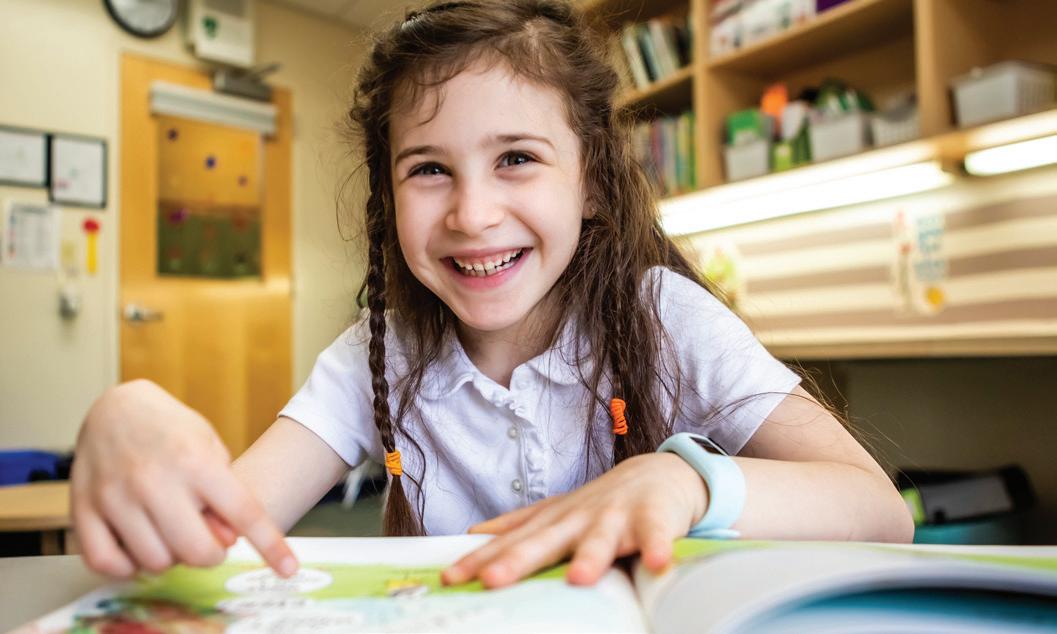

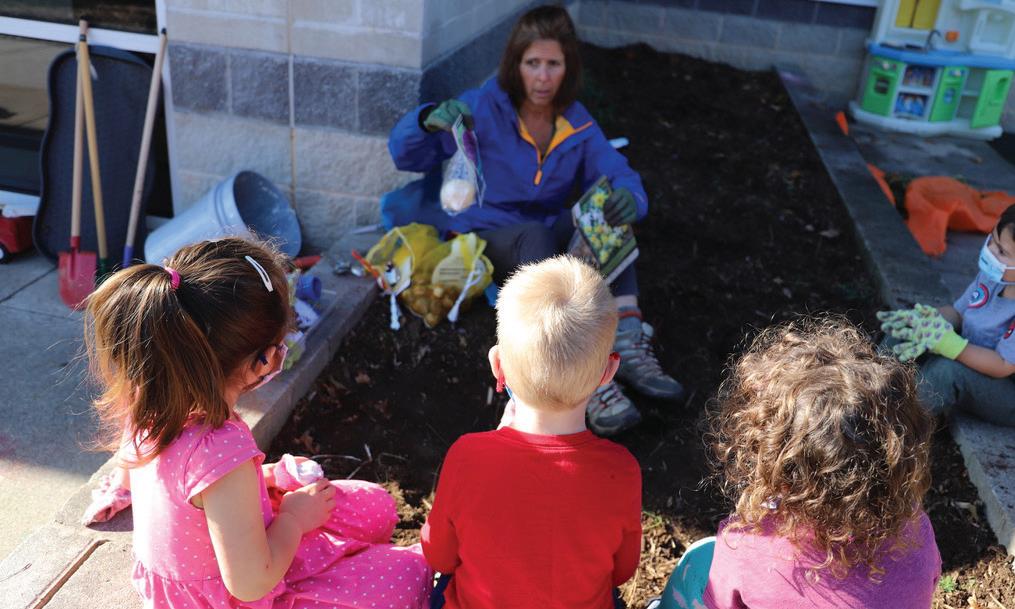
Through academic excellence and character development, Far Hills Country Day School provides each child brilliant beginnings for success in the modern world.

At Far Hills Country Day School, we champion both academic excellence and emotional intelligence.
Far Hills Country Day School challenges students to think independently and achieve confidently. The school’s shared growth mindset contributes to its experiential, student-centered approach to learning, its welcoming community of families, and its focus on developing individual strengths. At Far Hills, students are empowered to grow inward, outward, and upward and graduate prepared to lead at the country’s most competitive secondary schools.
Our graduates are known for their academic, artistic, and athletic achievements, yet it is their strength of character that truly distinguishes them. At Far Hills, students experience the freedom to discover and develop their authentic selves. They recognize and build on their strengths. They exhibit a spirit of growth that frees them to become resilient risk-takers. They grow into empathetic leaders, concerned citizens, creative problem-solvers, and independent thinkers who recognize their power to change the world.
Articulate and self-assured, adept at expressing themselves in their unique voice, Far Hills graduates know how to effectively advocate and communicate. Since preschool, they’ve been honing their public speaking skills, delivering an average of 86 presentations by graduation.
Secondary school guidance and placement at Far Hills provide families with thorough support in the selection and application process on the path to high school. As early as sixth grade, we begin working with parents and students to find the right-fit secondary school that will continue to challenge and encourage them. By eighth grade, the placement process is in full swing, including test preparation tailored to the high schools that students have identified.
Successful futures define our alumni. Far Hills graduates attend the finest boarding and day schools in the country. They arrive well prepared for all areas of the secondary school experience—from the classroom to the fields to the stage. With their strength of character and interpersonal skills, they emerge as leaders on campus.
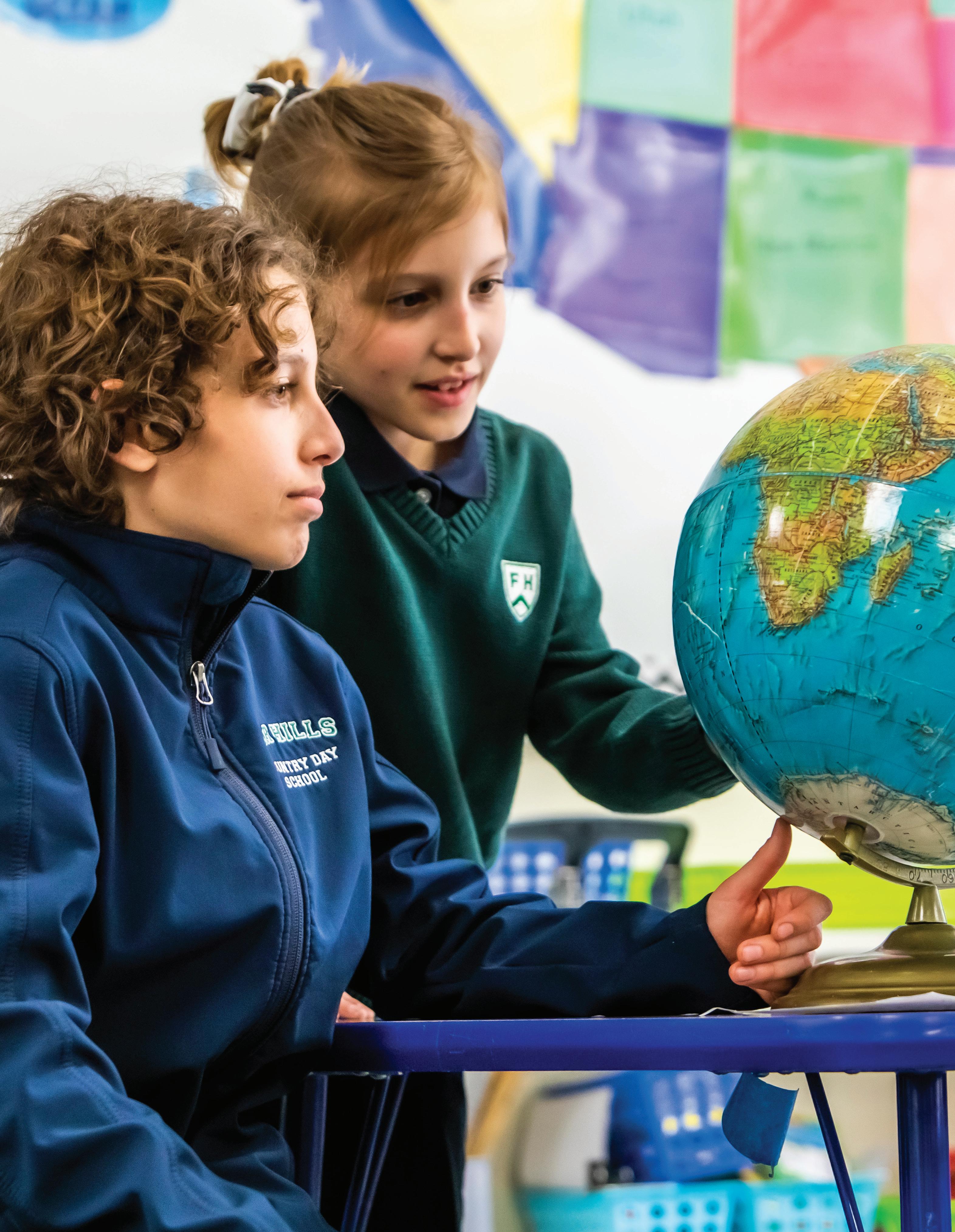

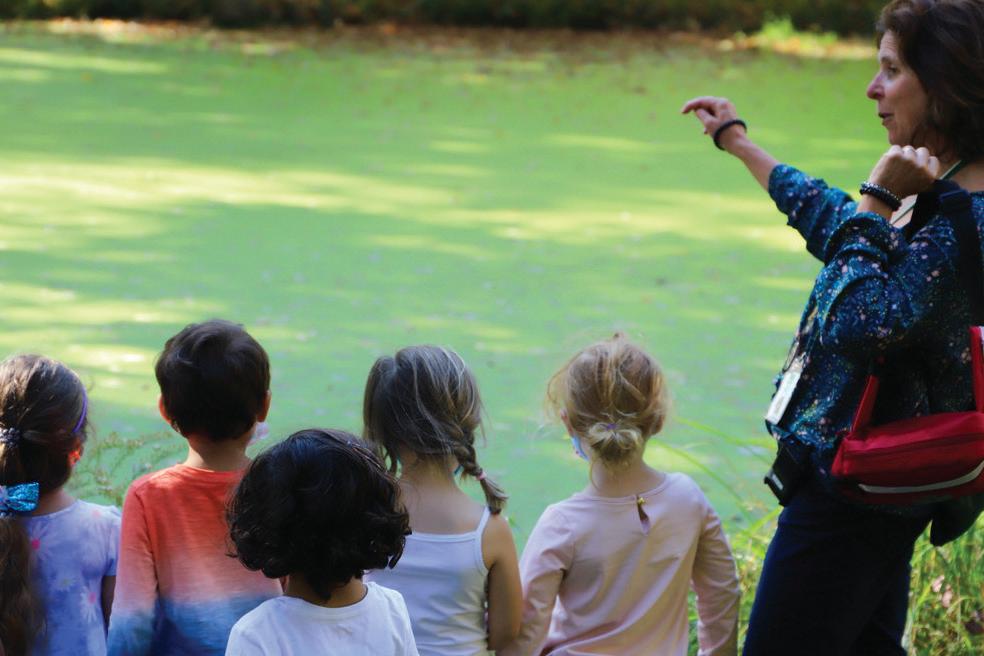
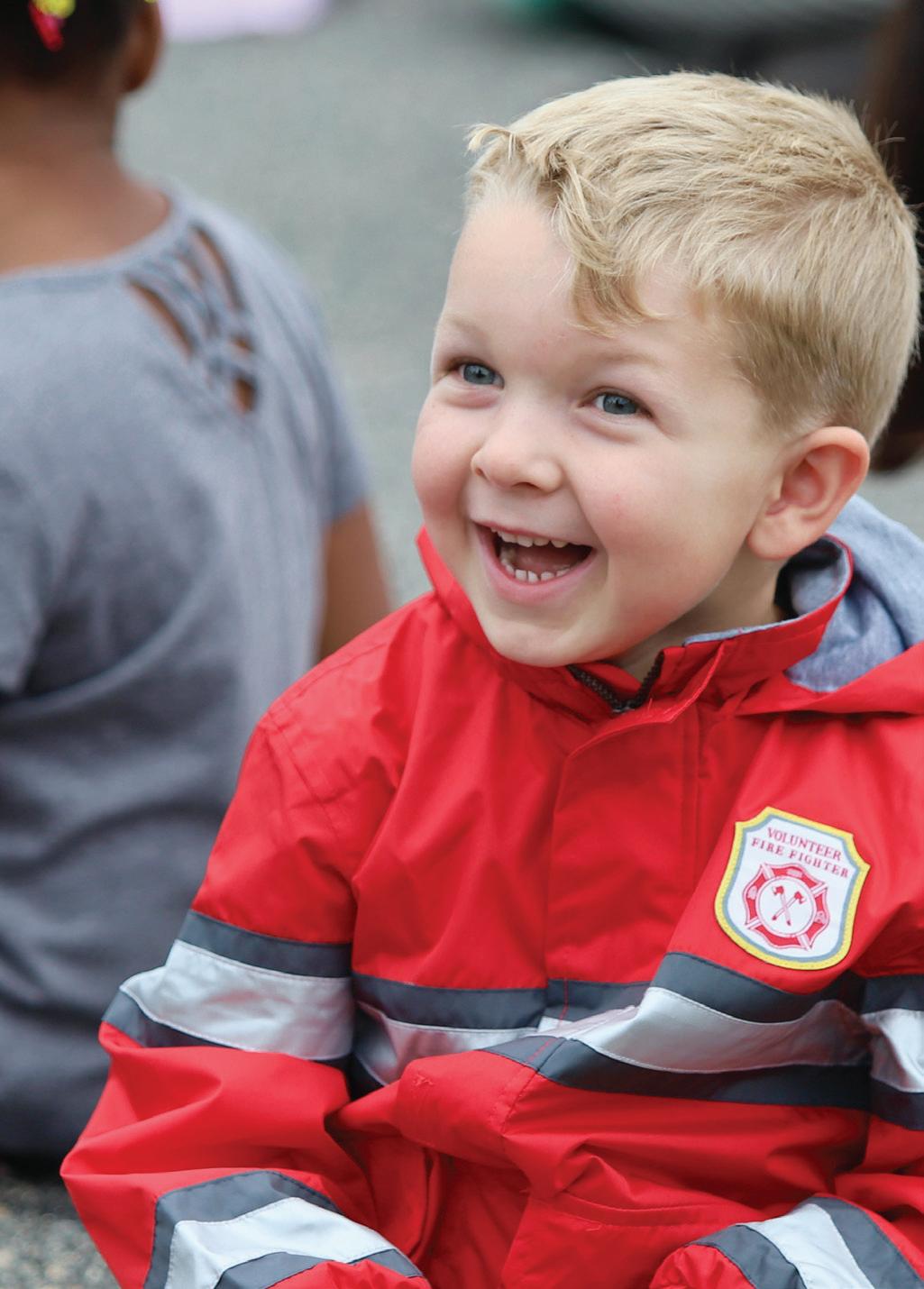

In Preschool at Far Hills Country Day School, we nourish curiosity at its peak.
Our students play, explore, and create as they discover how things work, answers to their questions, and ways of communicating their thinking and designs to others, which often include words and numbers.
With deep dedication, we honor the many nuances of our children’s social-emotional development. We allow for extended time and support of social problem solving and help develop empathy in our students.
What does emergent curriculum mean? It’s when a child’s interest is captured by something in the world around them and starts asking questions, we can help them explore those ideas more deeply through research. In turn, they develop more understanding of the topic, experiment with, test and refine their ideas, and engage in enthusiastic project work. The goal is always the creation of a project from the knowledge they have gained. This project-based learning is the key for students to fall in love with learning at a very young age.
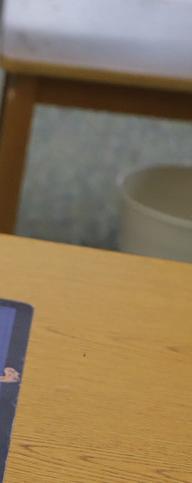
Preschool-age children have a natural curiosity about the world and a vivid imagination that shines through the reading and writing curriculum. Far Hills Country Day School’s Preschool students build reading and writing skills through multisensory phonics-based learning, interactive read-aloud stories, and group discussions. Students are captivated by interactive and memorable lessons, including rhymes, song and dance, and student choice.
Far Hills Country Day School’s Preschool students learn about themselves, their friends, and their community to develop empathy and an appreciation for what makes us unique. Students celebrate differences and learn about global celebrations and holidays around the world. They ask questions to help uncover an appreciation of the diversity of individual experiences.
Far Hills Country Day School
Preschool students explore mathematical concepts in a wide variety of creative and tactile ways throughout their day. From measuring and comparing the distances objects on our 54-acre
campus to counting out snacks to make sure that everyone is included, to using colorful blocks to create elaborate patterns, our Preschool teachers skillfully guide students through challenging and stimulating math-based activities.

Far Hills Country Day School’s Preschool students enjoy working with our Lower School Science teacher to develop a curiosity about all living and nonliving things. Students are encouraged to develop a love for the natural world and a desire to protect all creatures from the tiny worms we gently hold on the playground to the large animals we research in the classroom. Our project-based work approach naturally creates opportunities for hypothesizing and experimenting. Exploring what will float, how to concoct solutions that make bubbles or color mixing—immersive learning is the best kind of learning!
Preschool children begin their language learning experience at Far Hills with exploratory Spanish. The skill of listening is prioritized above all others at this acquisition stage. The youngest of our student population requires a feeling of security before learning can occur. Our teachers utilize the Total Physical Response Method to convey basic ideas and vocabulary in this manner.
Far Hills Country Day School’s Preschool Music class is designed to prepare the students to become musical by being able to sing the tunes that they hear and develop in their heads, feel and move to the pulse of the music, and be able to group that pulse in twos and threes
and to react to the feelings that music can give. Our preschoolers perform in three concerts throughout the year: Preschool Holiday Concert, All-School Grandparents’/Special Friends’ Day Concert, and End-Of-School-Year Picnic/Showcase. These concerts are age-appropriate and integrated into their classroom curriculum, as well as including songs from various cultures and languages.
Preschool students experience visual art through a curriculum that is multisensory and differentiated. In Preschool, our artists study various mediums of art that are linked to their curriculum. Linking storytelling to artmaking helps to develop socialemotional skills through artmaking and self-reflection and also continues the process of language acquisition. Art projects are linked to the major topics that are studied in their classes, which helps the students solidify concepts through cross-curricular connections.
At Far Hills Country Day School, the Library and media literacy lessons are guided by the American Association of School Librarians’ (AASL) National School Library Standards. The six foundations of these standards are: inquire, include, collaborate, curate, explore, and engage. In Preschool, students focus on fiction stories, authors, and illustrators and are introduced to nonfiction.
At Far Hills Country Day School, social and emotional skills are just as valuable as academic skills. In our Preschool classrooms, students learn how to recognize the feelings of others, work and play cooperatively, use discussion and compromise to resolve conflict, and develop the confidence to share ideas. The Preschool students actively engage in our Five Pillars of Character—Kindness, Respect, Responsibility, Honesty, and Leadership—with the entire Lower School. Through our Community
Meetings, we establish an interactive format where the students discuss these characteristics together. We also acknowledge students who have exhibited the characteristic for the month. These 5 Pillars of Character are the foundation of our social-emotional learning and are embedded in our curriculum on a daily basis.
By the end of Preschool, Far Hills Country Day School students will be able to:



• identify our written language and begin to use that knowledge to be able to express themselves and have an awareness of how other people express themselves using language;
• understand math as a language that represents the quantity of something;
• ask questions and make comments pertinent to a story and/or text being read and connect the information in books to personal life experiences;
• engage in language play (such as rhyming and identifying and isolating sounds in a word); and
• pose questions and gather data about themselves and their surroundings.
Far Hills Country Day School’s Kindergarten serves as the bridge between the emergent curriculum and readiness skills formed in our Preschool and the foundational skills necessary for continued success and independence. We provide a balance between honoring students’ individual interests and a developmentally appropriate introduction to the Lower School curriculum by conducting studies as a whole group, small group, and 1:1 lessons.
Far Hills honors the unique age of Kindergarten students and their gradual transition into a formal learning environment by focusing on social-emotional skills, helping students understand what it means to be part of a learning community, and assisting them in developing the mindset of a learner. They problemsolve and experience what it means to be resilient and persevere through challenges.
Each trimester, our expert Kindergarten teachers build upon the students’ maturation and self-confidence as learners. They support the mastery of academic skills and conceptual understanding in Kindergartners—this promotes intrinsic motivation for children and keeps them excited about learning.
Our Kindergarten students have two opportunities to practice their
public speaking skills through the Kindergarten Play and the Kindergarten Wonders Project.
Language Arts: Reading and Writing
Far Hills Country Day School’s Kindergarten classes work with differentiated guided reading groups that allow students to learn to read grade-level appropriate texts and beyond, with a focus on comprehension. Students explore poetry, fiction, and nonfiction and produce personal responses to literature. Our Orton Gillinghamtrained Kindergarten teachers focus on phonological awareness. Students learn and practice sight words daily using games and movements while also learning the mechanics of reading, directionality, and identifying parts of a book.
Far Hills Country Day School’s Kindergarten students learn foundational skills using HMH Into Reading’s science-backed, explicit, systematic instruction. Using the Letter Knowledge routine, students will gain alphabet knowledge, including an understanding of the primary sound. Students learn uppercase and lowercase strokes and practice writing each letter on the Know It, Show It practice pages. Lively, engaging lessons model language and use photos to prompt students to apply their acquired skills. Phonetics
and fluency are practiced when students use decodable texts that contain new and previously taught phonetic elements. Students have opportunities to apply what they have learned during independent practice and small group activities.
Students also have the opportunity to work with members of our Reading Support Team, either 1:1 or in small groups throughout each week, to continue to challenge them on their reading level while encouraging them to gain fluency and self-confidence in their reading ability.
Students begin their writing journey in Kindergarten by telling a story with a picture and labels. They progress to short written phrases and eventually complete sentences. The Handwriting Without Tears program provides multi-sensory, kinesthetic, hands-on instruction for students to learn and practice writing letters.
The “Read to Feed” program helps Kindergarten students improve their literacy skills while teaching the value of giving back to families in need. Each time a student reads a level-appropriate book to themselves, a partner, and then a teacher, they will use a stamp of a dime to fill in a Ten Frame. As a grade level, once we fill in 100 spots, we will then vote on an animal (a



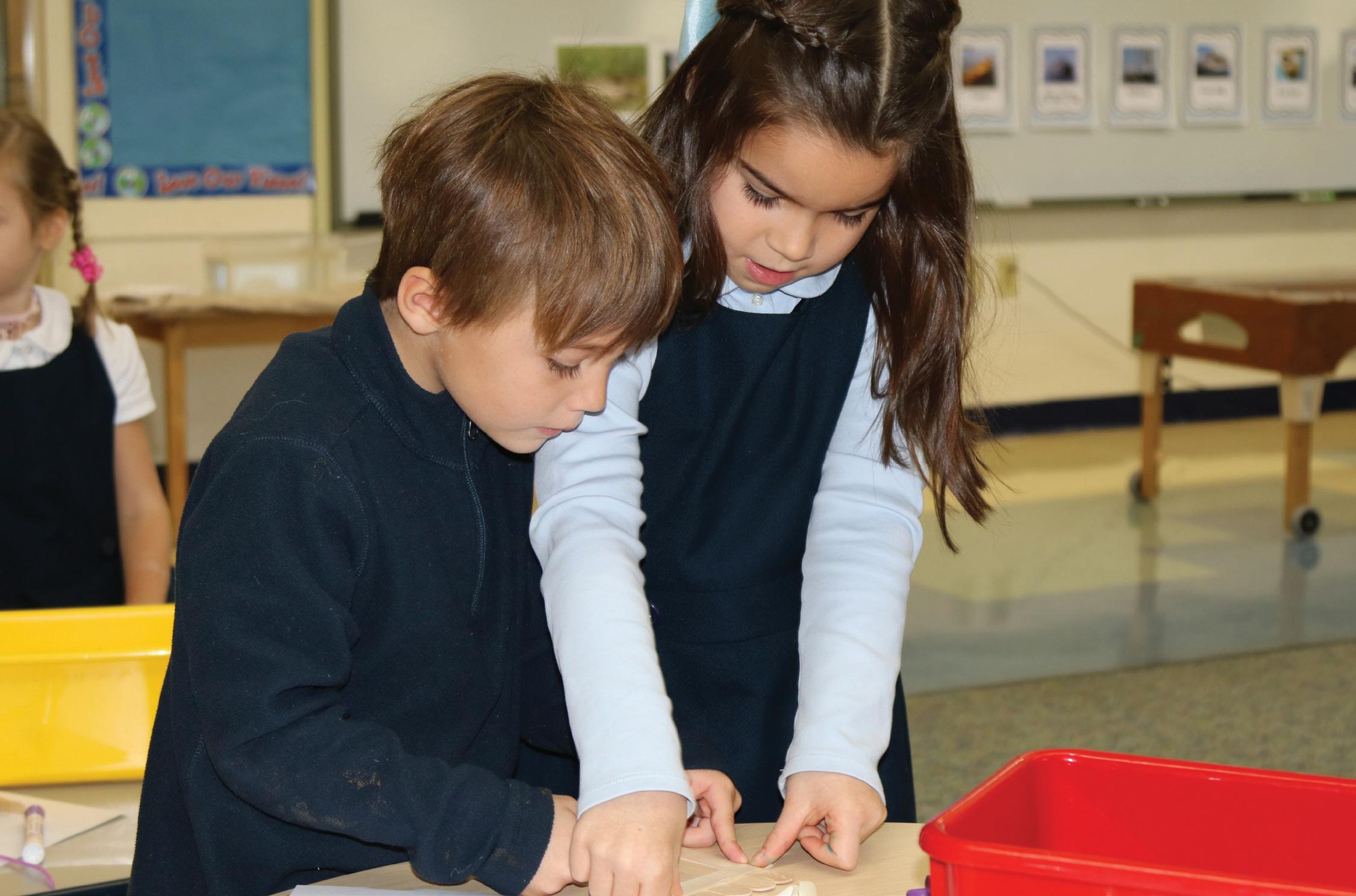
cow, chicken, alpaca, etc.) to send to families in need.
Our Kindergarten students explore, discover, and discuss the similarities and differences in people and places. They start by taking a close look at home life and gradually zoom out to learn about world communities. Building from there, the students learn to identify rural, urban, and suburban communities. Students also explore and learn to identify the differences between needs and wants.
In Kindergarten, students develop a strong number sense by learning to count to 100 by ones, twos, fives, and tens, identifying and writing numerals, and comparing and ordering whole numbers. Using objects, pictures, and number models, students create addition and subtraction sentences. Students continue to build their math skills by collecting and organizing data in tally charts and bar graphs and developing a vocabulary to help them express concepts of geometry and spatial sense, using appropriate language to describe attributes to compare objects according to length, weight, and size. Kindergarten students build on the foundation of pattern creation established in Preschool through a variety of daily calendar activities. Math support and enrichment are available 1:1 if needed, and a Far Hills math specialist pushes into class when appropriate.
Kindergarten students celebrate all of their math skills with Mathland, when students have the chance to teach their parents math games and activities.
Through hands-on exploration, inquiry, and skill development, Kindergarten students learn about science phenomena across Life, Earth, and Physical Science disciplines. Core skills include: observing, asking questions, defining problems, making models, and communicating both verbally and through journal writing. Kindergarteners get to explore topics that include plant and animal needs, sunlight and warmth, trees, sustainability, and forces. By the end of the school year, Kindergarten students are able to work safely in a lab setting. The signature sciencebased project for Kindergarten is a ‘Pond Dip’ with Raritan Headwaters, which examines the health of our on-campus pond by studying the variety of macroinvertebrates.
In Kindergarten, routine is established as the children begin to introduce themselves in Spanish, expressing basic greetings and phrases. Colors, numbers, family members, animals, and parts of the day are all presented and practiced throughout the year. New foods are exposed to the children in various culinary projects to celebrate Spanish culture.
In Kindergarten, music classes continue to focus on skills developed and explored during the Preschool years. They continue to learn how to sing, begin to explore music literacy and perform on various classroom percussion instruments. Students also experience music and movement classes where they learn to master fine and gross non- and locomotor skills through music. Our Kindergarten musicians perform in three productions throughout
the year: K-8 Holiday Concert, Kindergarten Playwright Production, and the Lower School Closing Ceremonies.
Kindergarten students are introduced to pottery and handbuilding with clay, painting, and drawing, while creating landscapes and self-portraits. Through experimentation, Kindergarteners build skills in various media and approaches to art-making. Students learn to interpret art by identifying subject matter and describing relevant details. Students also work on a cross-curricular project as they create the theatrical scenery and props that will be used in the Kindergarten play.
Kindergarten students start to leverage technology to practice skills, learn information, and communicate their knowledge. They primarily use iPads and are introduced to a number of apps and tools to help them accomplish various goals. The concept of Digital Citizenship is introduced with a focus on staying safe online and finding a balance with offline activities. Students start to learn about coding concepts through a combination of unplugged lessons and appropriate apps, including work with the Dot robot. All of this comes together when students enjoy the opportunity to use the green screen and Shadow Puppet app for their signature “Wonder” project.
In Kindergarten, students continue to focus on fiction stories, authors, and illustrators and are introduced to nonfiction. Kindergarten students begin to learn about the research process as they use Thinking
Maps to take notes and learn about paraphrasing, writing, using nonfiction resources, and citing sources. Their learning is typically expressed with a particular digital tool (PicCollage, Google Slides, Google Sites, Book Creator, etc.).
Far Hills Country Day School’s Kindergarteners continue to build on the social and emotional skills they started in Preschool. In Kindergarten, we incorporate Far Hills Country Day School’s Five Pillars of Character into our daily curriculum. Kindergarten students have a main focus on the Pillar of kindness throughout the year. The students learn to recognize and record acts of kindness they witness in and out of the classroom.
During Physical Education, Kindergarteners are given the tools and the confidence to participate in physical activity. Using activities such as cooperative games, individual games, and team games, students are encouraged to challenge themselves outside their comfort zones.
Capstone Project: “The Wonder Project Expo”
The Wonder Project Expo celebrates the curiosity and enthusiasm of Kindergarten students while bringing together research and interview skills, art and creativity, and public speaking and presentation skills.
Students begin with one main “wonder,” or guiding question, and spend much of the third trimester studying nonfiction resources and employing research strategies to answer this and other questions related to their topics. Students learn to listen for information and record facts from books and videos, create science sketch drawings, and conduct interviews with expert volunteers from the FH community. Grade 4 reading buddies help students read, understand, and summarize printed resources and act as their first audience as Kindergarteners practice presenting their findings.
The Wonder Projects are a multicurricular effort as they incorporate library research lessons and the green screen and Shadowpuppet app in the Brain Space to pull all of

the information together. Finally, students proudly take to the podium in one of the first of many public speaking experiences at FH to share their research project slideshows and circle map posters with the school community.
By the end of Kindergarten, Far Hills Country Day School students will be able to:
• print upper- and lower-case letters of the alphabet and the numerals zero to nine using standard form, proportions, and spacing;
• count to 100 using ones, twos, fives, and tens;
• read and comprehend Kindergarten-level texts independently;
• write a complete thought in complete sentences with proper punctuation and grammar; and
• make predictions, formulate questions, record observations, and communicate results.
Our goal is to teach students strategies to use in their daily lives to successfully solve problems and build positive peer relationships. We have organized lessons, including daily Morning Meetings, and teach and model examples of mindfulness. Students are encouraged to use these routines in their daily interactions throughout the school and beyond their FH experiences.
Grade 1 is packed with essential and exciting transitions as students leave behind much of the play of Preschool and Kindergarten and begin to dive deep into academic skills. Students will go through a significant shift to more extensive learning. Our exploration of Science, Math, Reading, Writing, and Social Studies is complemented by rotating special subjects such as Learning and Design, Spanish, Music, Physical Education, and Visual Arts.
Far Hills Country Day School’s Grade 1 students continue to build upon their foundational skills using HMH Into Reading. Students refer to model language that introduces each skill and prompts application. Pictures and lively activities engage students as they practice sounds and build their vocabulary. Students use a routine that guides them to see, say, spell, and write the words they’re studying. Students have opportunities to apply what they have learned during independent practice and small group activities.
Students have the opportunity to work with teachers either 1:1 or in small groups to receive instruction with targeted reading objectives.
The Grade 1 Writing program is structured for students to gain the

knowledge and skills necessary for foundational writing instruction and achievement. Through modeling and mini-lessons, students develop an understanding of the writing process. Students organize and express their thoughts in writing and compose concise sentences and paragraphs. Students also have opportunities for low-stakes writing sessions, which allow students to develop a comfort for expressing ideas during independent and creative writing.
The Grade 1 Social Studies program revolves around communities. The students become aware of how individuals in our classroom, school, neighborhoods, and world communities are dependent upon one another. Through a variety of literature, photos, and videos, students learn about diversity and
appreciate the different cultures from around the world. Students culminate the year with an extensive continent research project in which they use several non-fiction sources for research purposes.
The Grade 1 Math program focuses on understanding that mathematics is a way of organizing information and representing it with numeric symbols. Students continue to expand their ability to communicate their mathematical thinking and to problem-solve efficiently. Students concentrate on composing and decomposing numbers, learning addition and subtraction facts
and strategies, ways to represent numbers, and problem-solving. Students learn skills to understand place value, which includes reading and writing numbers, ordering and comparing, and extending patterns. Students use these learned skills to problem solve in real-world everyday situations.

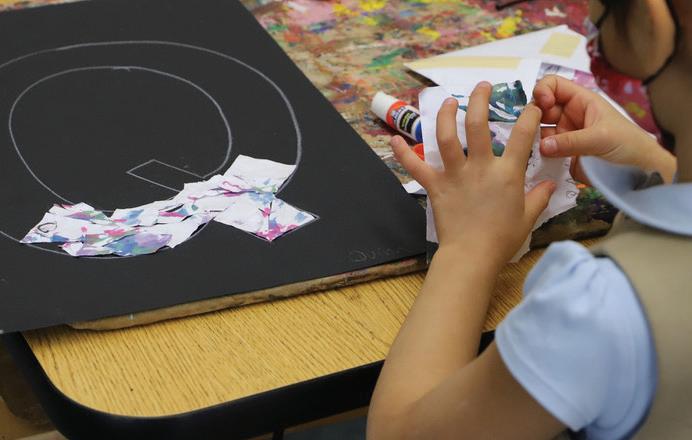
In Grade 1, students explore broad topics in Life, Earth, and Physical Science through many hands-on science investigations. The unit on Plant and Animals helps students understand that organisms have special parts and behaviors that help them to grow and meet their needs.
Students explore the properties of light and sound by playing sound effect artists, creating head harps, making paper-stained glass models, and sharing secret signals with peers. The Earth and Space unit helps students learn that the sun, moon, and stars change position in the sky in ways that are fun to watch and predict. The star projector model is a highlight, giving students the opportunity to investigate why stars are visible at night but disappear during the day. In late winter, students explore the process of making maple syrup by tapping the sugar maple trees on campus. Throughout the year, students go on seasonal nature walks to better understand bees and pollination, butterfly habitats, the dragonfly life cycle, and pond life. In addition, students design and make an animal habitat model at the end of the year to support their multidisciplinary Australian or African Expo project. Various skills are practiced throughout the year, including observing, asking questions, making models, planning and carrying out investigations, analyzing and interpreting data, and measuring.
As routines and basic greetings have been established in the first grade, reinforcing essential vocabulary becomes the new focus. Puppets help portray the elementary Spanish storybooks in a more lively fashion, as the children begin to express the names of their family members and
some daily activities in the target language.
Grade 1 music classes take a deep dive into researched musical pedagogy such as ones developed by Zoltán Kodály and Orff Schulwerk. The students explore music through singing, performing on instruments, music literacy, music improvisation, and moving to music. They also continue with music and movement classes that integrate into their study of continents and learn various cultural dances and songs. Grade 1 musicians perform in three productions throughout the year: K-8 Holiday Concert, First Grade Play, and the Lower School Closing Ceremonies.
During Visual Art classes, Grade 1 students are introduced to weaving, as well as painting and drawing including landscape in the style of the Post-Impressionists. Grade 1 artists explore empathy and understanding of the self through the “We’re All Wonders” project.
Grade 1 students also work on a cross-curricular project as they create clay animals for their continents and habitats study. Students will also interpret art by categorizing subject matter and identifying the characteristics of form.

Students in Grade 1 expand their facility with previously introduced iPad apps while adding tools like the Popplet app for creating graphic organizers and the Tynker app for coding. Their independence with the iPad continues to increase as they use it as a tool to gain knowledge, organize thoughts, and present
information. Digital Citizenship concepts expand from safety to being responsible and respectful online. Students add the concept of loops to their coding practice as they work with various apps and the Dot robot. They also practice the Design Thinking process with a focus on defining the problem to inform brainstorming. The Capstone Africa/ Australia Project is enhanced with the use of the green screen.
Grade 1 students learn about fiction story elements, biographies, and how to read nonfiction for research purposes. The research process continues for Grade 1 students, as they use Thinking Maps to take notes, and learn about paraphrasing, writing, using nonfiction resources,
and citing sources. Their learning is typically expressed with a particular digital tool (PicCollage, Google Slides, Google Sites, and Book Creator).
Grade 1’s Social-Emotional program is based on the school’s Five Pillars of Character. Students are taught strategies that enable them to solve problems successfully and build positive peer relationships. We teach and model examples of mindfulness, including Keeping Calm and being our B.E.S.T (body language; eye contact; say nice things; tone of voice). Students are encouraged to use these strategies in their daily interactions throughout the school and beyond.
During Physical Education, Grade 1 students are given the tools and the confidence to participate in physical activity. Using activities such as cooperative games, individual games, and team games, students are encouraged to challenge themselves outside their comfort zones.

Capstone Project: “Grade 1 Expo”
The Grade 1 Expo focuses on a cross-curricular deep dive into a continent that includes Art, Science, Social Studies, Writing, Research, and Learning and Design. During the project, Grade 1 students learn about the biomes, landmarks, animals, and peoples of the continent. Grade 1 students:
• create a topographical map that shows the different biomes and landmarks;
• apply that knowledge of mapping (including such things as a title, compass rose, and map key);
• research continent-specific animals using books, articles, and websites;
• create a thinking map to organize their notes;
• use the thinking map to write a mini research paper that includes a title page and illustrations; use a variety of mediums to create their animals;
• use materials to make their habitat; and
• present their topographical maps and research to the Grade 1 families.
By the end of Grade 1, Far Hills Country Day School students will be able to:
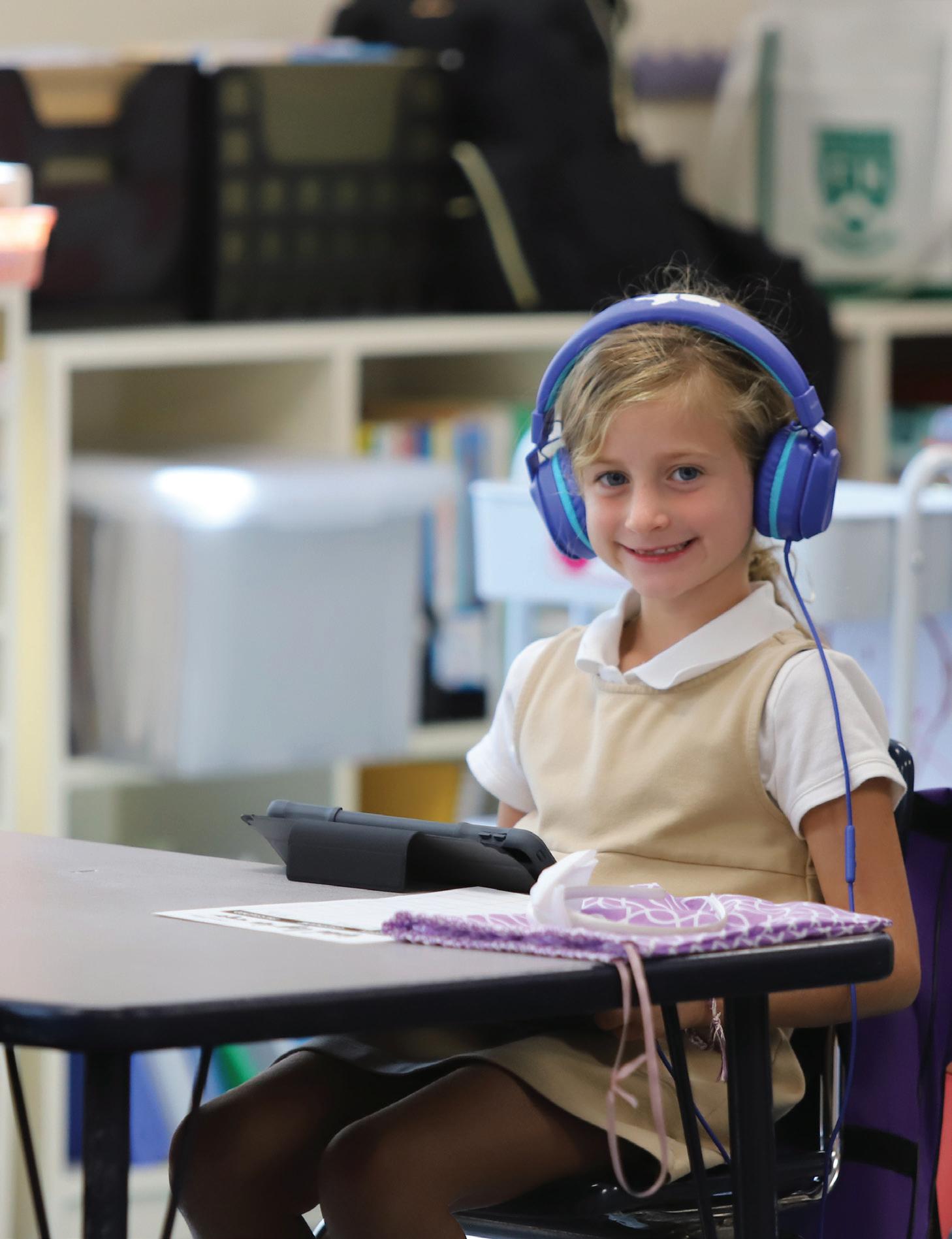
• read and comprehend text with accuracy, fluency, and comprehension;
• use efficient strategies to solve problems and communicate mathematical thinking; and
• construct complete sentences on a focused prompt, using varied sentence patterns, standard spelling, and common punctuation.
Grade 2 serves as the year to build foundational academic skills, challenge students to the next level, build mission skills, build “student skills,” and cultivate a love of learning. All disciplines in the Grade 2 program intentionally include cross-curricular components, the Far Hills Pillars, and mission skills.
In Grade 2, your child becomes a more experienced writer and reader by practicing their skills in more complex and comprehensive ways. Students read bigger and more complicated books and write longer and more in-depth pieces. Grade 2 students hone their presentation and research skills and are engaged in research and critical thinking projects.
Grade 2 continues to reinforce the foundational skills they acquired and built upon in Kindergarten and Grade 1 at Far Hills Country Day School, using HMH Into Reading. Students use modeled language that introduces each skill and prompts application. Pictures and lively activities engage students as they practice sounds and build their vocabulary. Students use a routine that guides them to see, say, spell, and write the words they’re studying. Students have opportunities to apply what they have learned during independent practice and small group activities.
Students have the opportunity to work with members of our Reading Support Team either 1:1 or in small groups throughout each week to
continue to receive individualized instruction with targeted reading objectives.
Grade 2 has a comprehensive writing program centered around writing a complete paragraph. Students learn about starting with a strong opening sentence, adding several detailed sentences, and ending with a concluding sentence. During their time in Grade 2, students will write personal narratives, imaginative stories, persuasive essays, and informational pieces. Spelling and grammar skills are studied and practiced weekly.
The core of Far Hills Country Day School’s Grade 2 Social Studies curriculum is empathy. Our Social Studies units revolve around the important idea of understanding the human condition and the diversity of cultures and experiences throughout the world. Students study changemakers and learn what characteristics define people who have created changes for the better in this world. Students also learn about leadership and discover the traits that make for a positive, effective leader. The final Grade 2 Social Studies unit is about immigration and is studied through the Coming to America Capstone Project.
Grade 2 Math at Far Hills Country Day School finds students maturing in their mathematical thinking. They continue to develop mastery of addition and subtraction skills while using basic fact fluency to add
and subtract three-digit numbers. They also learn about place value and manipulate numbers up to 1,000. Problem-solving is a big part of the Grade 2 Math curriculum and a variety of strategies are used to explain thought processes. The concepts of multiplication, division, and fractions are introduced and students continue to study geometry, money, and time concepts.
Building upon hands-on exploration, inquiry, and skill development, Grade 2 students learn about science phenomena across Life, Earth, and Physical science disciplines. Core skills are reinforced: observing, asking questions, defining problems, making models, communicating both verbally and through journal writing, and planning and carrying out investigations. Topics include air and weather, animal biodiversity, erosion, earth surfaces, matter, and material properties. Grade 2 students observe chicks hatching and learn about the development inside the eggs. At the end of the year, students will be able to work safely in a lab setting, use more science tools, follow the scientific process, practice Design Thinking, and will have strengthened teamwork skills. Two signature projects for Grade 2 students include doing a detailed study of an organism, the Penguin; and, building a parachute using Design Thinking skills.
Grade 2, reading and writing goals become more developmentally




appropriate as the children learn the Spanish alphabet to convey the days of the week, the date of the month, their family members’ names, and some of their favorite activities. Students participate in the Parts of the Body project, where they describe themselves using common verbs.
The Penguin Project is a crosscurricular highlight of this year. As an annual signature project, the students demonstrate their learning of body parts and other personal details by comparing themselves to a fictional penguin friend in the Spanish language.
Grade 2 Music classes promote active music-making by giving the students the opportunities to create, perform, respond, and connect to
music in various ways. Students perform on a variety of instruments, from ukuleles to pitched xylophones to drums from all over the world. They continue to learn to read music on the treble clef staff and master dances and songs from various countries from around the world. Grade 2 musicians perform in four productions throughout the year: K–8 Holiday Concert, Second Grade Project-Based Learning Coming to America—A Study of Immigration and Empathy, Grandparents’/Special Friends’ Day Concert, and the Lower School Closing Ceremonies.
Grade 2 students are introduced to mixed media art and design, including printmaking, the study of historical sculpture and design, and a final painting project of the Statue of Liberty in connection with
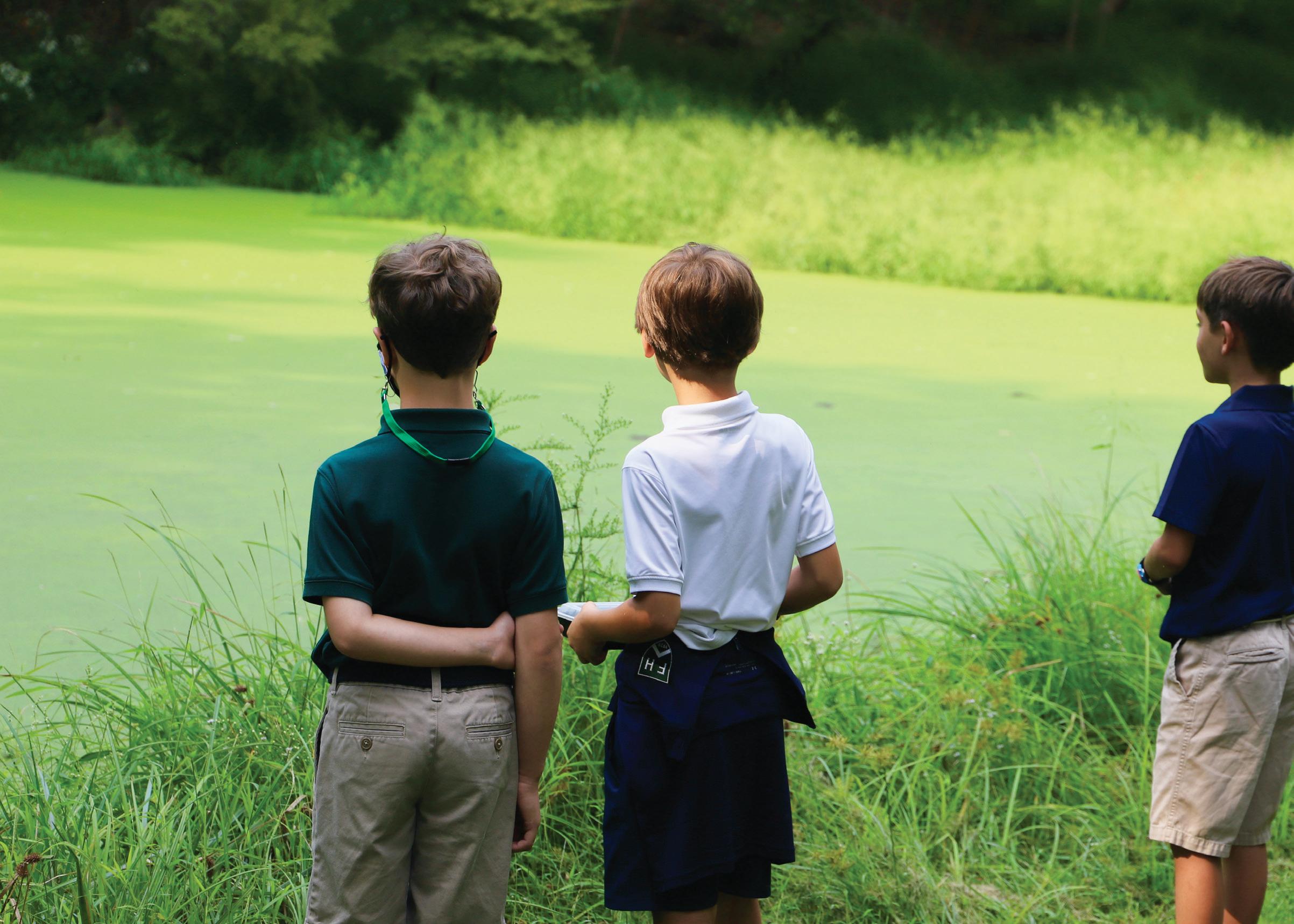
Far Hills Country Day School’s Grade Far Hills Country Day School’s Grade 2 students utilize their iPads as an integral tool in the learning process. Lessons focus on increasing their comfort and advancing their skills with familiar apps as they create content for a variety of subjects. The concept of Digital Citizenship moves towards privacy and understanding a digital footprint. Students use the Dash robot in addition to Dot and other resources as they continue their coding work with sequences and loops. The concept of working through iterations as part of the Design Thinking process is introduced. Many components of the Grade 2 Capstone Coming to America project are integrated into
the Coming to America Capstone Project.Digital Learning and Design class, including a field trip to the Tenement Museum using virtual reality technology, designing an item that they brought for their journey, and the individual immigration stories recorded using the green screen.
Far Hills Country Day School Grade 2 students study U.S. symbols to prepare for their immigration study and look more closely at nonfiction resources for research purposes. The research process continues for Grade 2 students as they use Thinking Maps to take notes and learn about paraphrasing, writing, using nonfiction resources, and citing sources. Their learning is typically expressed with a particular digital tool (PicCollage, Google Slides, Google Sites, and Book Creator).
Grade 2 students practice mindfulness techniques daily to help them learn to go from a flight or fight reaction to a more measured response. Learning the neuroscience of the brain helps students understand how our brains work and why we react to the world the way that we do. Grade 2 uses a children’s program called “Brain Talk Therapy” to understand how our amygdala, prefrontal cortex, and hypothalamus work together to help us be deciders rather than just doers.
Grade 2 students also learn about the “Piglet Mindset.” Through observing and virtually getting to know a little blind and deaf dog, students learn about optimism, resilience, perseverance, and acceptance. Students are encouraged to bring a Piglet Mindset into their everyday lives.
During Physical Education, Grade 2 students are given the tools and the confidence to participate in physical activity. Using activities such
as cooperative games, individual games, and team games, students are encouraged to challenge themselves outside their comfort zones.
By the end of Grade 2, Far Hills Country Day School students will be able to:

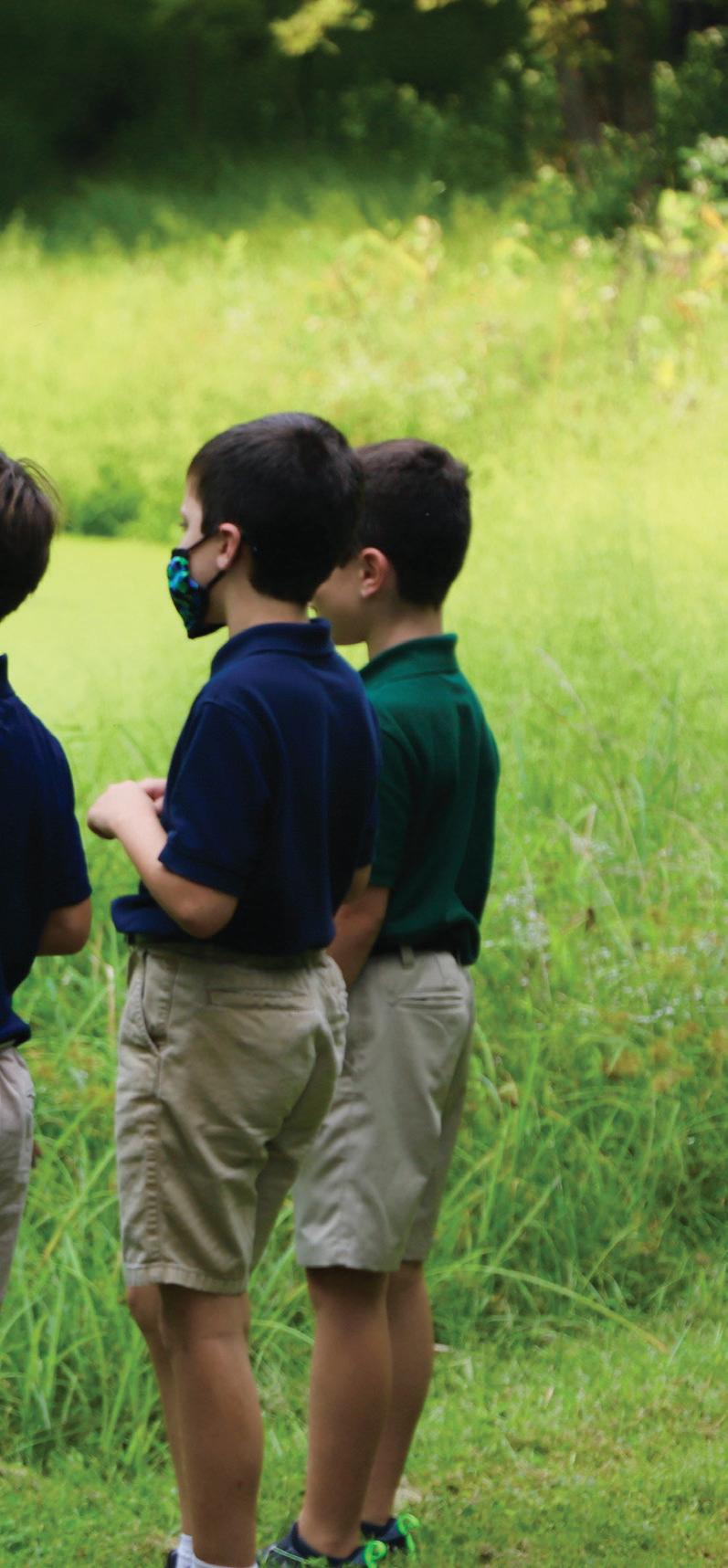
• sustain independent reading;
• use strategies based on place value to add and subtract numbers with and without regrouping;
• write in a multitude of genres with a beginning, middle, and ending; and
• read and spell 150 HighFrequency words.
Grade 2 serves as the year to build foundational academic skills, challenge students to the next level, build mission skills, build “student skills,” and cultivate a love of learning. All disciplines in the Grade 2 program intentionally include cross-curricular components, the Far Hills Pillars, and mission skills.



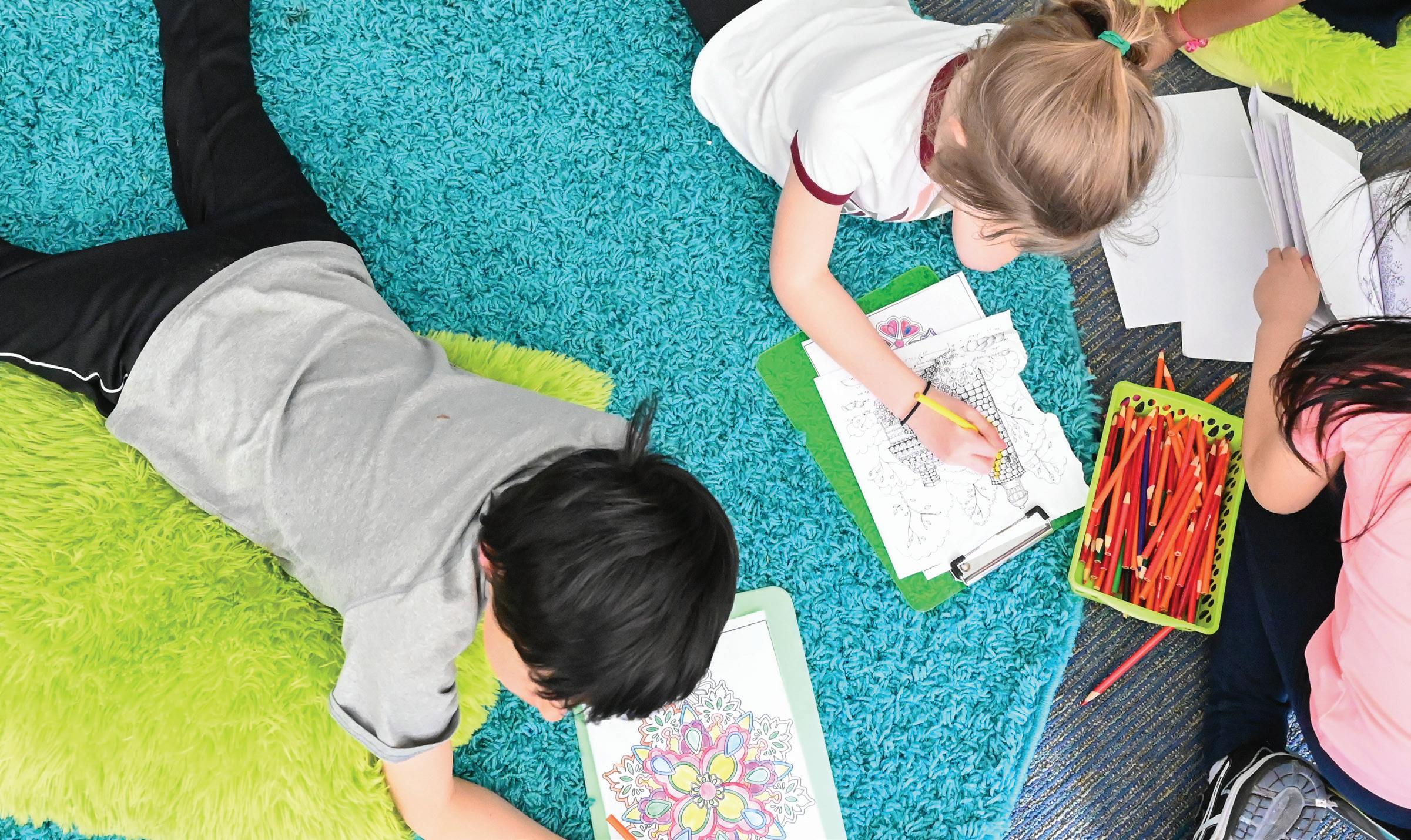
Grade 3 is a year of tremendous growth and preparation. Teachers encourage students to be active learners by asking questions, taking on the responsibility of becoming independent students, and growing as individuals. Students become confident in their ability to persevere through a given task and grow as resilient problem-solvers regardless of the subject. Every day our Grade 3 students are presented with opportunities for social interaction, mindfulness, kindness, public speaking, teamwork, resilience, and so much more.
Questioning is a key component of Grade 3. While most people have moved away from the continuous questions we asked as a child, we “relearn” the art of questioning. Students explore the concept that “opening our minds to our own curiosity and asking the questions of how and why help “train our brains” to gain more knowledge in all that we read, research, and learn.
“Reverse Questioning” is a skill often used to start the day in Grade 3.
Through this, the students receive an answer and must allow their minds to go through backward thinking to arrive at a question that would end with a given answer. Teaching students to be better questioners results in becoming better thinkers.
Far Hills Country Day School’s Grade 3 students continue to learn their reading and writing skills using HMH Into Reading. Text topics continue to progress so that students systematically build an understanding of meaningful topics and academic vocabulary. Having adequate decoding skills, students are able to comprehend more complicated texts. Students begin to develop ownership of learning through the meaningful independent choice of rich, authentic texts. Opportunities are provided for evidence-based discussions and writing. Lessons are accessible and flexible so that students are engaged in tailored instruction.
Grade 3 students have the opportunity to work with members of our Reading Support Team either 1:1 or in small groups throughout each week to continue to grow their reading confidence and skills, including decoding, fluency, and comprehension.
Grade 3 students learn that writing is a cornerstone for effective communication. Using Thinking Maps as a pre-writing tool, students brainstorm and draft ideas in paragraph form. They edit and revise drafts to clarify the main idea, refine details, strengthen word choices,
and correct spelling, capitalization, and punctuation. Students learn to write narrative paragraphs, begin exploring expository essays, and persuasive writing. They also learn the cursive alphabet and enjoy opportunities to read and write in cursive throughout the year. Spelling is an integral part of writing instruction. Students practice spelling patterns and correctly spell words in independent writing.
Grade 3 Social Studies focuses on reading nonfiction sources and developing research skills. This is practiced through a class study of New Jersey. Students then have the opportunity to apply these skills through the Grade 3 Capstone Project, Adventure America. In this project, each student is a state to research. Students create a multifaceted, cross-curricular project which they present to the entire Far Hills community.
An overarching goal of the grade three math program is extending number sense concepts through 10,000. They learn to mentally compute through estimation by rounding numbers to the nearest 10, 100, and 1,000. They evaluate answers to make sure they are reasonable. Multiplication and division mastery continues as
students use strategies including repeated addition and subtraction, arrays, number lines, and skip counting to solve problems. They further their study of unit fractions by exploring fractions that represent parts of a whole and parts of a set. A year-long emphasis on strategies for solving real-world problems independently and cooperatively forms the backbone of our Grade 3 curriculum.
Relying upon hands-on exploration, inquiry, and skill development, Grade 3 students learn about science phenomena across Life, Earth, and Physical Science disciplines. Core skills are reinforced: observing, asking questions, defining problems, making models, communicating both verbally and through journal writing, planning and carrying out investigations, and analyzing and interpreting data. Topics include insects, habitats, lifecycles, monarch butterfly rearing, bald eagle study, plate tectonics, rocks and minerals, volcanoes, and sound. At the end of the year, students will be able to work safely in a lab setting, continue to use more science tools, follow the scientific process, and will have strengthened teamwork skills. The signature STEAM project for Grade 3 includes building instruments using recycled materials while using the engineering design process.
A major theme for Grade 3 Spanish class is the change of seasons and everything associated with the weather—clothing, food, likes and dislikes, and more. Cross-curricular activities with Science and Social
Studies are utilized to truly reinforce certain vocabulary and phrases, especially related to the monarch butterfly (biology) and Adventure
America projects (geography). In the Spanish language, students create a collectible card of their assigned state with basic information such as important or famous landmarks, interesting statistics, and any distinct geographical features.

Grade 3 Music classes bring out each student’s musicality by fostering an appreciation for singing, performing on instruments, creating music, and composing music traditionally and electronically. Music literacy at this grade level adopts the “reading to learn” approach where the students are given the recorder to learn how to read and perform music. Grade 3 musicians perform in three productions throughout the year: K-8 Holiday Concert, integration of performance and composition for their Grade 3 Adventure America studies, and the Lower School Closing Ceremonies.
Grade 3 students are introduced
to the analysis of intent and abstraction. Throughout the year, they will study postal art, philately, and intaglio, and will create a postcard in connection to their Adventure America Capstone Project. Students will create personally satisfying artwork using a variety of artistic processes and materials, determine messages communicated by an image, and elaborate visual information by adding details in an artwork to enhance emerging meaning.
Grade 3 students experience a significant change as the Chromebook becomes the primary tool for learning. The concept of cloud computing and the collaborative features of various Google tools are integrated in stages throughout the year. Students begin with basic word processing skills and become familiar with other presentation tools. Digital file naming and folder organization are critical for developing strong
organizational skills. Learning about the home row keys and proper keyboarding skills are crucial using the Typing Club platform. Digital Citizenship is addressed when creating strong passwords and with the responsibility of getting an internal email account. Students also learn about responsibly using information and technology by understanding the meaning of plagiarism and the importance of copyright. The concept of using events when coding is introduced. The capstone Adventure America project provides the opportunity to display many components on both the show board and the completed Google Site.
In Grade 3, time in the library focuses on digital resources for research purposes. Students learn how information is organized in print and online sources and how to search these resources efficiently and effectively. They also study media literacy, which includes
evaluating websites and online images for accuracy and reliability.
Every day our Grade 3 students are presented with opportunities to exemplify the Far Hills Pillars of Character: Honesty, Respect, Responsibility, Kindness, Leadership. Through direct instruction, literature, videos, sharing circles, and role playing, students improve their ability to problem solve and navigate interpersonal relationships. Through daily academic challenges that include independent as well as small-group interactions, they also practice and develop our mission skills: Teamwork, Ethics, Time Management, Creativity, Resilience, and Curiosity.
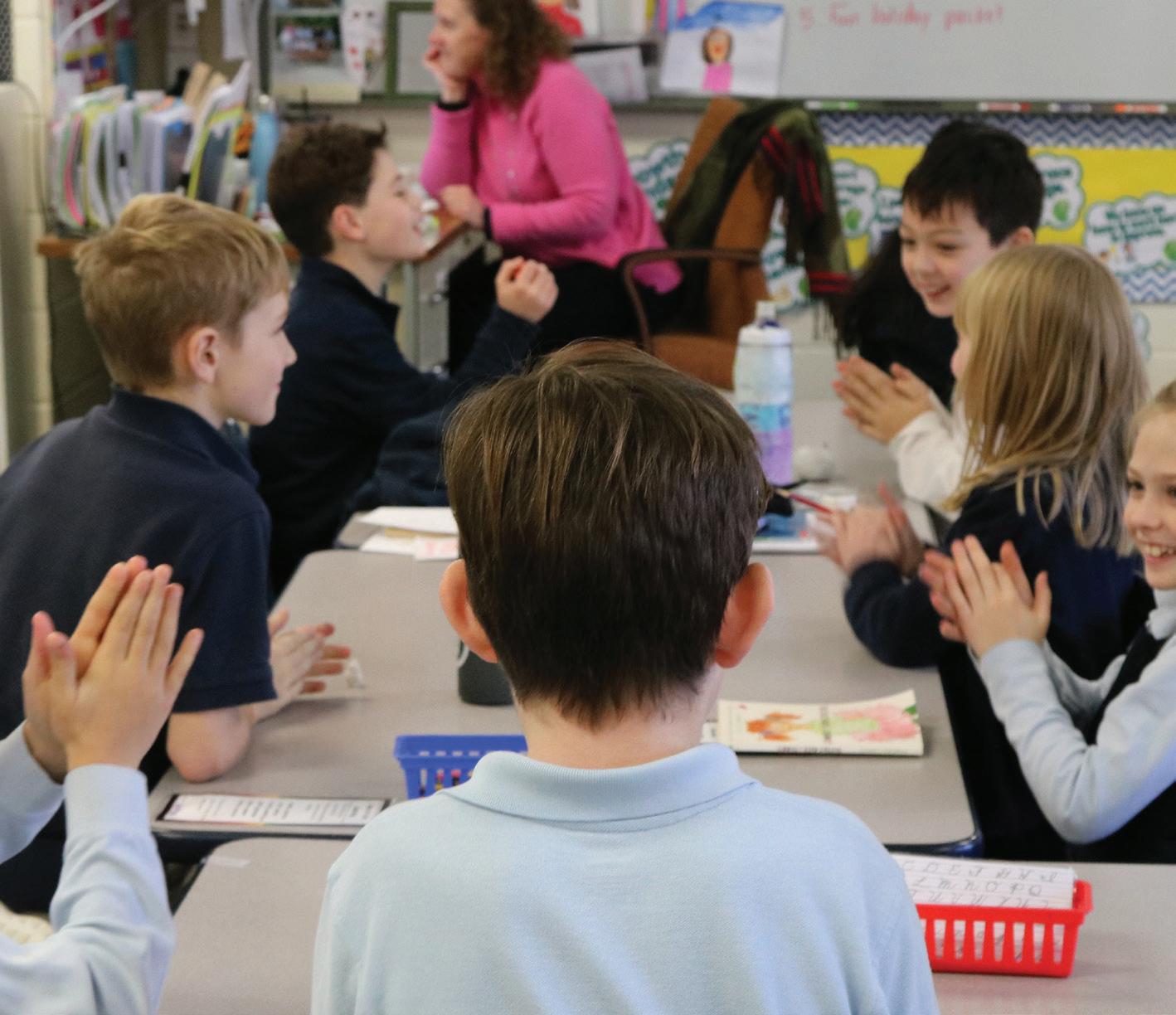
During Physical Education, Grade 3 students are given the tools and the confidence to participate in physical activity. Using activities such as cooperative games, individual games, and team games, students
are encouraged to challenge themselves.
The Capstone project for Grade 3 is known as “Adventure America.” Each third-grade student is assigned a state that they independently research, using the skills learned in their whole-group New Jersey study. In doing this research, they become an expert in topics related to their assigned state. This project is multi-faceted and cross-curricular. Students produce two informative essays as well as a persuasive essay designed to convince someone to visit their state. Aspects of this project are completed in special subject areas such as Spanish, Art, Music, Library, and Learning and Design. Students apply elements of the engineering/design process to build a replica of a landmark in their state using only recycled materials. The final products of this project include a show board, a Google site, a 3D landmark, and three essays. Students prepare an oral presentation and present all of their materials to their families and the entire school community at our Adventure America Fair.
By the end of Grade 3, Far Hills Country Day School students will:
• have the tools they need to become independent learners and critical thinkers;
• be on their way to becoming successful lifelong readers and writers; and
• have extended number sense concepts to use for real-world problem-solving involving multiple operations (addition, subtraction, multiplication, and division).
By Grade 4, academic challenge has increased significantly, and subjects have become more sophisticated. Grade 4 students are more responsible and are beginning to think critically and informatively. Students begin to utilize more advanced strategies and can interpret and analyze information at a higher level.
Using HMH Into Reading, Far Hills Country Day School’s Grade 4 students have the opportunity to work independently, following a personalized path that accelerates their learning. In their small-group learning environment, students receive targeted, data-driven instruction while building meaningful relationships with their peers and teacher. Independent reading engages students with their choice of content and allows them to apply newly acquired vocabulary and comprehension skills. Introduction and engagement with a full range of writing modes and forms allow students to engage with the writing process.
Grade 4 students continue to build on their writing skills throughout the year with a focus on strengthening and advancing their expository and narrative writing. They publish multiple works, using various Thinking Maps to organize information. From here, students are taught the structure of an opening and closing paragraph, as well as the main body of a text with appropriate
supporting details. They continue to improve and evaluate their writing with multiple drafts, working to hone their editing and revising skills. Students produce writing in the following genres: reflection, narrative, expository, descriptive/ creative, and persuasive. Students analyze words by composing and decomposing the parts, such as roots, prefixes, and suffixes. Students engage in word studies that focus on spelling patterns and sounds.
Through an inquiry-based Social Studies curriculum, Far Hills Country Day School’s Grade 4 students explore an “Essential Question” (EQ) each trimester from the perspective of Indigenous people, explorers, and early settlers in America. Students engage in research, take field trips, and learn from guest speakers in order to discover the answers to the essential questions.
• Trimester One EQ: How do people utilize the land for their survival and for their advantage?
• Trimester Two EQ: What are the possible outcomes when different cultures encounter each other? Within a singular culture, how does an individual contribute to a larger society?
• Trimester Three EQ: How and why do individuals or groups of people in a community share their ideas and experiences to make their perspectives known widely?
While exploring these questions, empathy is developed as the students seek to understand why people at different times in history made the choices that they made. In addition to empathy, Grade 4 students practice skills such as identifying critical details in nonfiction texts, note-taking (summarizing, paraphrasing, organizing), and comparing and contrasting different points of view.
Supported by their previous training, Grade 4 students increase automaticity with the basic facts of mathematics. They are encouraged to continue to apply their understanding of models, place value, and properties of operations to develop and use efficient and accurate methods to multiply and divide multi-digit numbers. They practice using estimation to determine the reasonableness of their answers.
Grade 4 students develop an understanding of fraction and decimal notation as an extension of the base-ten number system. They compare and order fractions and decimals and in doing so, extend their ability to recognize equivalent values.
Students also explore area as an attribute of two-dimensional regions and learn that a square unit is the standard unit for measuring area. As part of understanding two-dimensional shapes, students measure and classify angles.



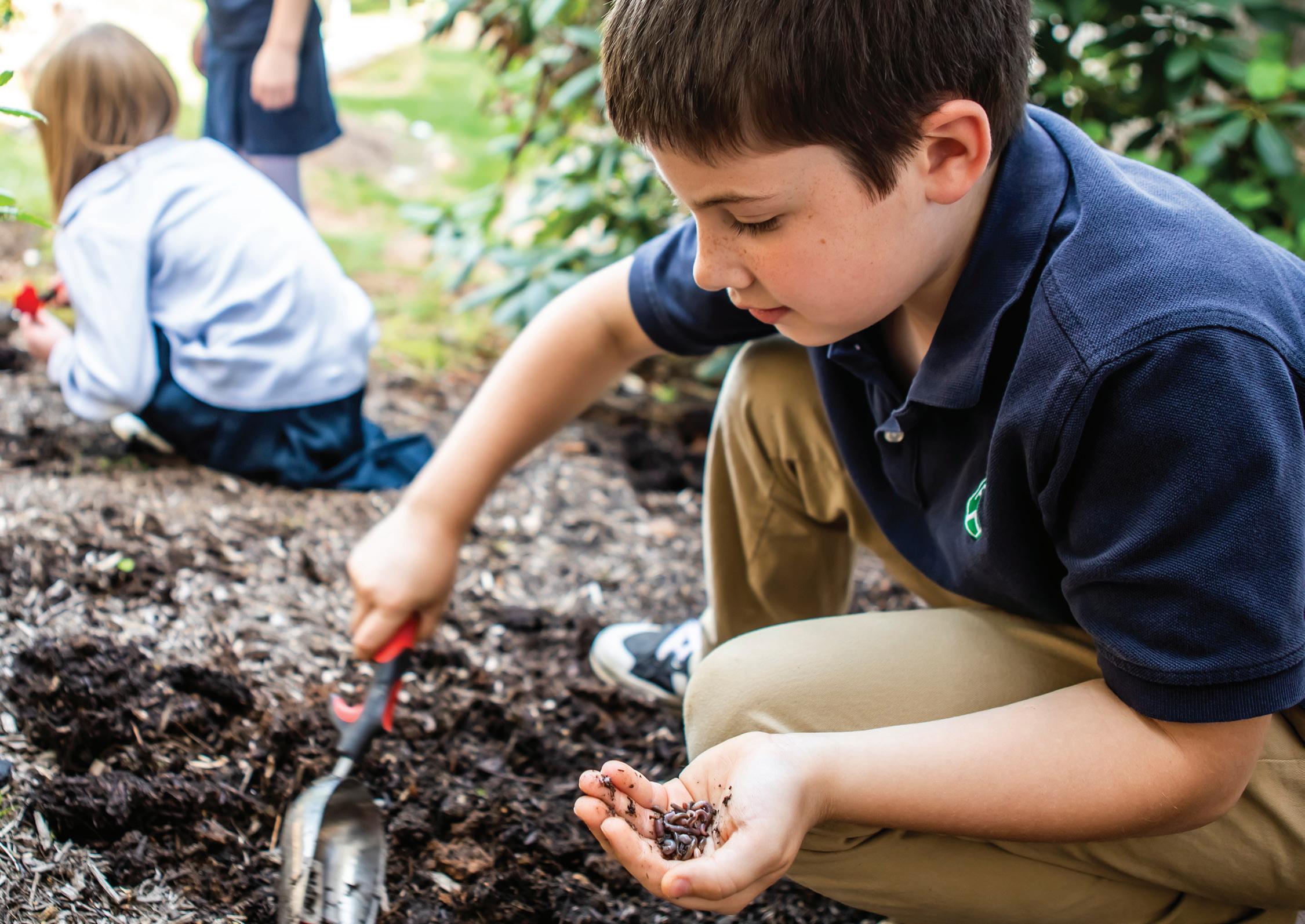
Students in Grade 4 work to build resilience as they grapple with multilayered problems and strengthen their ability to communicate their mathematical thinking.
Building on hands-on exploration, inquiry, and skill development, Grade 4 students learn about science phenomena across Life, Earth, and Physical Science disciplines. Core skills are reinforced: observing, asking questions, defining problems, making models, communicating both verbally and in journal writing, planning and carrying out investigations, analyzing and interpreting data, computational thinking, constructing explanations, and designing solutions. Topics include energy, natural resources, magnetism, electricity, microscopes, astronomy, the human body, and plant pollination. At the end of the year, students will be able to work safely in a lab setting, use more science tools, follow the scientific process, and independently plan experiments, and will have strengthened teamwork skills. The signature project for Grade 4 includes a culminating astronomy experience where Greek mythology stories about constellations are told in a Starlab dome.
In Grade 4, Spanish language communication and listening comprehension are emphasized above all in preparation for Grade 5. Students begin to encounter explicit grammar explanations and rules, such as using the most common verbs, “to have” and “to be,” and matching nouns with adjectives. During Hispanic Heritage Month, Grade 4 students have the opportunity to study a famous or influential historical figure.

Grade 4 students complete the “All About Me” project. In the Spanish language, students describe themselves (physical features and interests), their family, house, and other personal details using basic verb phrases and accumulated vocabulary.
Grade 4 students acquire music literacy skills, perform music on the xylophones, ukuleles, drums, and recorders, experience and sing music from various cultures and countries, and compose and create music traditionally and electronically. Grade 4 musicians perform in four productions throughout the year: K-8 Holiday Concert, integration of performance and composition for their Fourth Grade Expo, Grandparents’/Special Friends’ Day Concert, and the Lower School Closing Ceremonies.
In Grade 4, students brainstorm multiple approaches to a creative art or design problem. They explore and experiment with art-making techniques and approaches. Grade 4 students also create works of art that reflect community cultural traditions.
During Learning and Design class, Grade 4 students locate, organize, analyze, and synthesize information from various sources with the understanding that audiences may vary. Students become more sophisticated with all aspects of different Google tools and keyboarding skills progress using the Typing Club platform. Digital Citizenship topics are reviewed with new topics introduced, including individual technology use, media choices, and online activity continue to increase. Grade 4 continues to learn about plagiarism, copyright, digital etiquette, and internet safety. Coding skills develop with individually paced platforms and collaborative activities and the concept of conditionals is introduced. The Grade 4 Colonial Capstone Project is a culmination of acquired skills as the students exhibit their abilities as active learners and content creators.
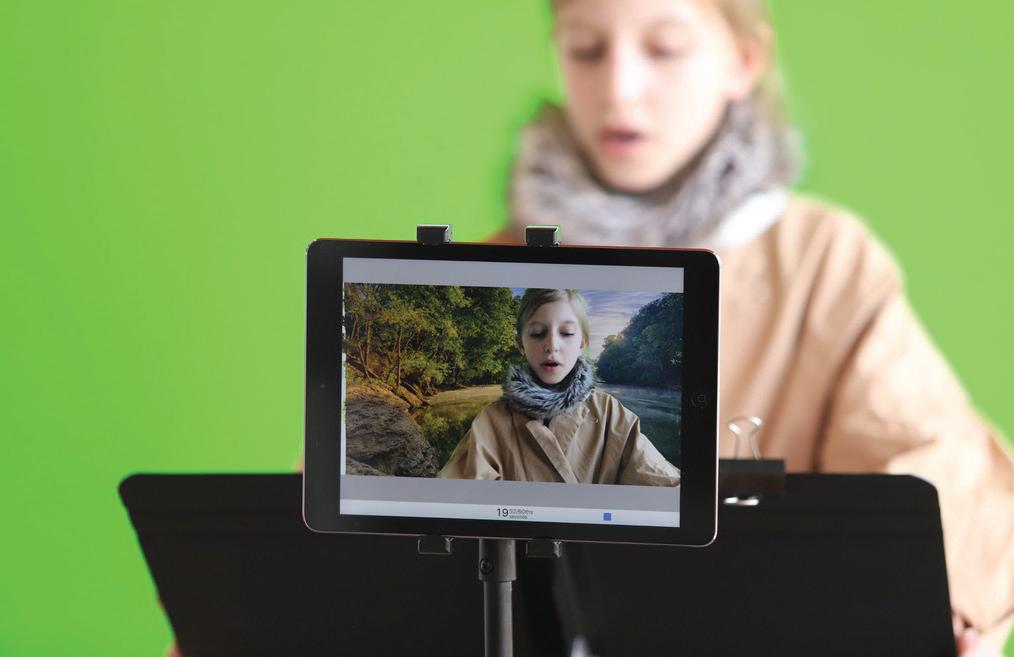
In Grade 4, students continue to learn how information is organized in print and online sources and how to search these resources efficiently and effectively. They also study media literacy, which includes evaluating websites and online images for accuracy and reliability.
In Grade 4, students work to use their words to communicate their feelings with others in order to solve conflicts. We use different cross-curricular activities to incorporate the following skills:
• self-awareness (recognize one’s own emotions, thoughts, and values);
• self-management (effectively manage stress, controlling impulses, and motivating oneself);
• social awareness (empathize with others, including those with diverse backgrounds and cultures);
• relationship skills (maintain healthy relationships with others including communicating clearly, listening well, and cooperating with others); and
• responsible decision-making (make choices about personal behavior and the well-being of oneself and others).
During Physical Education, Grade 4 students are given the tools and
the confidence to participate in physical activity. Using activities such as cooperative games, individual games, and team games, students are encouraged to challenge themselves outside their comfort zones.
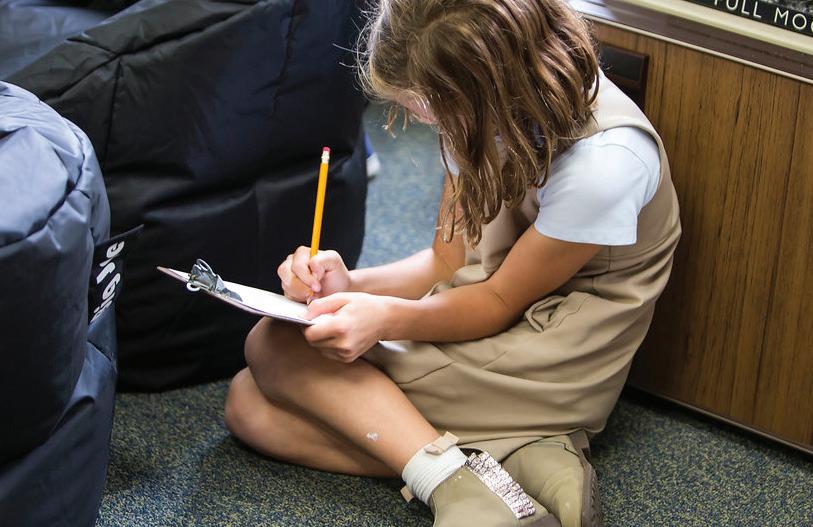
Capstone Project: Grade 4 Expo
The Grade 4 Expo is the culmination of a student’s Lower School years at Far Hills. This multidisciplinary project has a significant writing component central to the Grade 4 Language Arts curriculum.
Throughout the year in Social Studies, background knowledge is developed as students learn about early settlers in our country and the events that led to the American Revolution. Students examine both the perspective of the colonists and that of King George III. Each student is then assigned the role of a colonial tradesperson. This helps to frame the project for them and gives them a platform from which to begin their research.
Students spend the first few weeks researching the tools and materials of their respective trades and their primary customers. Based on their findings, students then decided if it would be in their best interest to remain loyal to King George or join with the Patriots. These findings are drafted into a four-paragraph essay
that states arguments both for and against the issue. After deciding on a position, students then craft speeches aimed at persuading audience members to support their views.

Additionally, the arts are woven into the Expo as students study and perform the music of the Revolutionary War, perform an adapted version of “My Shot” from Hamilton by Lin Manuel Miranda, create a three-dimensional project in Art class based on their colonial trade, and create their own costumes and props.
By the end of Grade 4, Far Hills Country Day School students will be able to:
• revise writing to strengthen content and incorporate vivid, precise language;
• demonstrate effective time management strategies and complete work by the due date; and
• use place value strategies to multiply and divide multi-digit numbers.




Grade 5 students are provided meaningful scaffolded HMH Into Reading lessons in whole-class instruction, teacher-led smallgroup lessons, and a variety of independent practice activities to meet a wide range of learners. As confident readers, students are taught to recognize genre characteristics, cite text evidence, and draw from a growing bank of skills and strategies to make meaning from complex grade-level texts. Students read, write, and talk about texts, naturally building background and knowledge about grade-level cross-curricular topics and standards.
Grade 5 History introduces students to the study of Ancient Civilizations, such as Mesopotamia, Egypt, Mali, Greece, China, the Aztecs, the Maya, and the Inca. Students examine the geography, economies, societies, and cultural history of these areas and learn about the impact geography has on the development of culture. Students examine the geography, economies, societies, and history of these areas as they learn about the development of cultures. Collaborative projects, student presentations, and a field trip to the Metropolitan Museum of Art reinforce learned experiences and provide opportunities for exposure to primary source materials. Students refine their research skills by writing short pieces that answer essential, thoughtprovoking questions such as what was ancient Egypt’s most significant accomplishment. Students have the
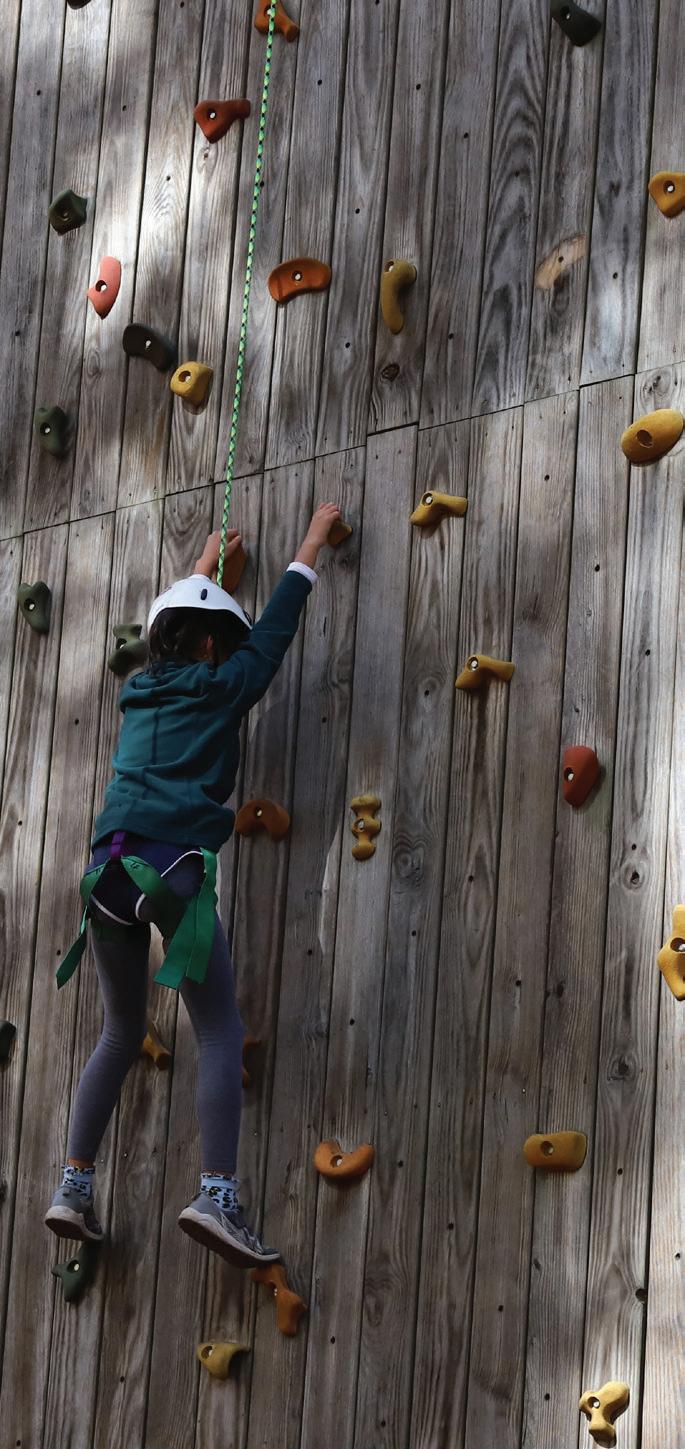
opportunity to share the uniqueness of their own cultures throughout the school year.
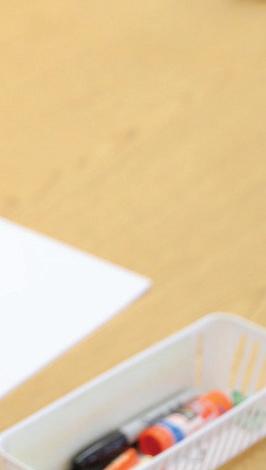
Grade 5 math students solidify their place value understanding and achieve multi-digit multiplication and division fluency. In addition, students deepen their understanding of the relationship among fractions, decimals, and whole numbers and learn to calculate with these different forms of numbers. Geometric and measurement concepts, such as angle and line relationships and triangle and quadrilateral explorations, lay the foundation for future coursework. Weaving together these units provides students with regular opportunities to hone problemsolving skills and apply their understanding to solve various real-world problems. Students who exhibit excellent motivation and display a curiosity and interest in underlying mathematical principles have the opportunity to be considered for placement into an accelerated course of study beginning in Grade 6.
Fifth grade scientists dive right into fundamental science topics interleaved within a year-long overarching theme of the ocean biome. Students are challenged with an engineering project that further develops their skills defining the criteria and constraints of a design problem with sufficient precision to ensure a successful solution. Broad themes include acquiring the vocabulary associated
with controlled experimentation, designing and conducting experiments, recording accurate observations, reviewing and using the Metric system for all measurement, becoming familiar with the concept of a system, and graphing data.
In Grade 5, students have the opportunity to experience both Spanish and Latin language courses. From there, they have the power of choice: they’ll select which language they will study in Grades 6–8.
Grade 5 students continue to build upon communicative skills that are initiated in the Lower School. Listening, speaking, reading, and writing are given equal importance, as the class is taught in the target language. Students read stories and informative texts, practice oral communication, learn critical phrases, and begin to conjugate verbs. Students learn about the cultural products and practices of the Spanish-speaking world, such as the music and dance of the Spanishspeaking world.
In Spanish, students deliver an oral presentation to the rest of the class, describing themselves through a drawn self-portrait.
Grade 5 Latin is a unique blend of the study of the language of Latin and an introduction to the ancient culture of Rome. Students begin their study of the Ancient Roman culture by entering the world of Pompeii and meeting the family of Caecilius, the Roman banker. Simultaneously, students analyze the language in new ways, such as identifying the roles a noun can play in a sentence, the etymology of derivatives and cognates, and the unusual sentence structure that Latin utilizes. This combination of culture and language study allows Grade 5 students an opportunity to ease into the study of a new
language. This introductory course encompasses half of Unit 1 of the Cambridge Latin Course.
For the final project of this course, students use a random scientific name generator to combine several Latin root words into a fictional plant-based creature, emphasizing the need for Latin and Greek vocabulary in discoveries of organic life.
Grade 5 Music class is centered around an in-depth study of instruments. During the course of the year, students will compose and perform music using traditional classroom instruments, Chromebooks, keyboards, flutes, clarinets, or saxophones. Students are expected to demonstrate proper embouchure and instrument assemblage as well as proficiency in music literacy skills. Students read and write melodic notation in the Treble Clef and simple rhythmic notation, including quarter, half, dotted half, eighth, sixteenth notes and their corresponding rests. In addition, students practice singing on pitch with proper posture. During Grade 5 Music class, crosscurricular connections are made to the students’ study of Ancient Egypt. Students learn about instruments from that time, the importance of music and performers, and then using recyclable materials, create a facsimile of an Ancient Egyptian instrument. Using Makey Makey, the students then turn their Ancient Egyptian instruments into playable replicas. The instrument class composition project includes writing an eight-measure melody for their instrument using a music notation program (Flat.io) and then creating an accompaniment in Soundtrap (a digital audio workstation). Continuing to apply their music literary skills, Grade 5 students learn to read from choral octavos and lead sheets as they prepare to perform in the annual holiday concert.
Visual Arts is a creative process that encompasses a variety of mediums
and skills that all students possess and develop during their Upper School years. Rooted in the National Core Content Standards for Visual Arts, each year there is at least one lesson that connects with other areas of study to help enrich the learning experience and facilitate lasting connections. Art class also includes learning about different artists, cultures, and modern-day experiences within the art world. Realizing their potential through the successes they have with multiple modalities (mediums) and concepts, students discover their passions and grow as artists.
Grade 5 student artists work on whale watercolors, a project that combines their scientific research with traditional water painting techniques learned in art class. Inspired by how whales move gracefully through the water and using their research as a reference, our student artists explore the importance of proportion, simulated surface textures, and line quality, without losing depth and details on a flat surface. The result is a beautiful painting that simulates these whales’ grace and agility when moving through the water.
Grade 5 student artists also explore the art of printmaking and the textile arts. Using a needle, thread, and traditional printmaking materials, students craft a soft pillow used when practicing mindfulness techniques. By constructing their pillow, this art-making experience becomes personal and unique to each student. The artwork featured on the front is crafted by hand using techniques specific to the art of linocut, a printmaking process that requires imagery to be carefully carved by hand and then printed to the fabric. Students learn practical textile techniques needed to complete their pillows, including basic stitches and knots.
Inspired by their studies of ancient civilizations, Grade 5 students
model a sculpture in the likeness of an Ancient Egyptian blue hippo sculpture, known as “William,” who resides at the Metropolitan Museum of Art. This unique crosscurricular project makes important connections between the visual arts and their studies of ancient Egypt. Much like the one found in the museum, student sculptures are constructed from kiln-fired clay. Students review Ancient Egypt’s rich history of burial practices and different styles of sculpture seen throughout history. Building upon skills learned last year, our artists learn firsthand, about the importance of balance, proportion, and textural design when working three-dimensionally.
Grade 5 marks the beginning of the Upper School, and the Chromebook is a vital tool as students travel to their academic classes. Facility with the different Google tools is integral for success as Classroom, Drive, and Gmail are used daily. Students extend their knowledge with Docs and Slides while adding work with Sheets to create tables and graphs. The Digital Citizenship topics of media balance, clickbait, online relationships, and cyberbullying are a focus for the year. Students study how Internet searches and databases work as they learn how to create effective queries for
searching. Students also continue to advance their coding skills through individually paced tutorials focusing on game design, music, and animation. If interested, students can choose to work in courses on JavaScript or Python.
Building on the strong foundation established in the Lower School study of the Five Pillars, Grade 5 students are introduced to the mission skills of time management, teamwork, and curiosity. This initial exploration allows students to connect the Five Pillars with the mission skills and identify how they already use them. Along with their advisors, Grade 5 students identify areas for growth with each of these mission skills and set appropriate goals for each trimester.

The guiding principles of the Upper School Athletic programs are: best effort, best attitude, best teammate. Through participation in sports and non-competitive activities students demonstrate the skills necessary to be successful in both team and individual sports. Students also have the opportunity to participate in challenge-by-choice programs, including our Ropes Course and Mountain Bike Trail.

By the end of Grade 5, Far Hills Country Day School students will be able to:

• write a three-paragraph response to a prompt with an introductory, body, and concluding paragraph;
• utilize a variety of strategies to develop note-taking skills of factual information;
• use various scientific tools and the metric system to observe and collect data;
• use efficient strategies for multidigit multiplication and division and apply to problem-solving situations; and
• understand fraction and decimal place values and develop fluency with fraction and decimal operations.
In Grade 6, Far Hills Country Day School continues to use HMH Into Reading in connection with grade-level appropriate novels and reading. As students transition into middle school literature, we use the foundational skills and texts from HMH Into Reading help students transition into confident readers and writers as they later navigate more challenging reading and writing assignments. To help students succeed in today’s world, they are provided daily opportunities to express their understanding and thinking in writing as well as during in-class discussions.
The Grade 6 History course introduces civics and offers a broad overview of American history and government. Students study significant political, social, and cultural developments, building an understanding of the development of the United States. Topics covered include the colonial era through the American Revolution, the early republic and expansion of the nation, and the Civil War era. Through multiple perspectives, students examine how the notions of liberty, equality, freedom, and democracy emerged and evolved throughout history.
Grade 6 math focuses on expanding students’ number sense. Students study ratios, rates, and proportions, emphasizing these critical concepts’ essential mathematical and practical
applications. Building from this unit, students also grow their thinking about ratios to develop a strong sense of percentages and their uses in the real world. Students explore negative numbers in realworld contexts and expand their conceptual understanding of the number system. Measurement conversions, identifying parts of the coordinate plane, investigating circle properties along with calculating the circumference and area will continue to develop the students’ geometric foundation. An introduction to algebraic expressions paves the way for the transition to algebraic reasoning and more abstract thinking as students develop their mathematical skills in Upper School.
Grade 6 science immerses students in the world of living systems. Learning what living organisms do, what characteristics they share, and how life is sustained builds awareness of some fundamental similarities in the patterns of species’ survival strategies. The study of the structure and function of organisms begins by focusing on the levels of organization. Students complete an in-depth study of one of the body systems. Cells, tissues, organs, and organ systems are presented and their actual relationships are described. Several dissections throughout the year allow students hands-on experience in understanding how their own bodies work. Students calculate the probability of various traits being passed from parents to offspring as
the year concludes with a study of genetics.
In Grade 6 Spanish, students begin to read authentic Spanish sources, such as magazines and websites. Students develop oral communication skills by using the verbs “ser/estar,” “tener,” and “gustar.” The present progressive tense and noun/adjective concordance are the target grammatical structures that are reinforced. By the end of the year, students can talk about their favorite hobbies, likes and dislikes, family members, and foods with relative fluency. Grade 6 students complete the “Nuestra serie de televisión” project. Students write, film, and edit their TV shows in Spanish by synthesizing all of their learning from their Grade 5 and Grade 6 language experiences.
Grade 6 Latin encompasses the second half of Unit 1 of the Cambridge Latin Course. Students continue their study of the Latin language by returning to the world of Caecilius and his family, focusing on education and what school was like 2,000 years ago. The eruption of Mt. Vesuvius and its catastrophic impact on the ancient world are studied at length. Linguistically, students master the three most common verb tenses (present, imperfect, and perfect) in all persons and the most foundational of noun cases (the nominative, dative, and accusative).


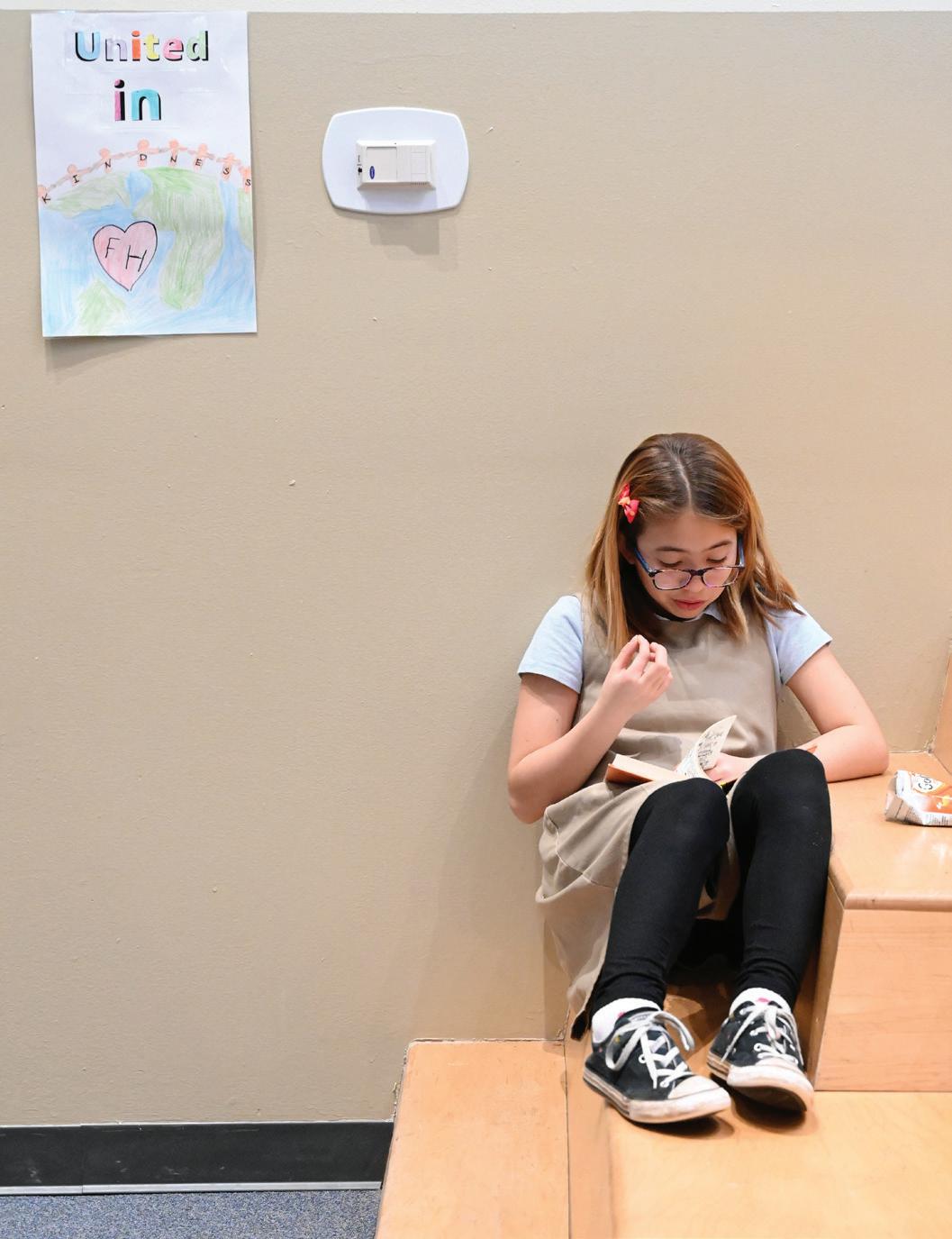

Grade 6 students complete the “Crea Deum” project. Students synthesize what they have learned about the ancient Greek and Latin pantheon by designing a new god or goddess that fits in with all the rest. Powers, relationships, and personality traits must all be thematically sound in the realm of mythology.
Grade 6 Music explores our nation’s history by listening to and examining famous songs of the Union and the Confederacy. As students learn what role music played in the Civil War and during the Civil Rights Movement, they can connect this with their study of American history. Grade 6 musicians continue to compose and perform music using traditional classroom instruments, Chromebooks, and keyboards in the Keyboard Lab. In addition, students continue to practice vocal music and singing on pitch with proper posture, in the classroom and at our formal concerts. Throughout the
year, the overarching question that Grade 6 students address is, which comes first, the lyrics or the music? The students work on a lyric project that requires them to find a song that tells a story, examine the lyrics and instrumentation, and facilitate a discussion about the song and its meaning.

Grade 6 Art class interleaves connections made within English and Science classes.
Pinhole Camera
Students construct a camera obscura (pinhole camera) from simple materials found around the home. This project brought together the art form of photography with the science of chemical reactions and the properties of light. Students practice various photographic techniques and consistently evaluate their lighting and camera angles. This process enables student artists to make informed decisions that impact the overall outcome of their
work and draw upon skills that will later be applied in their science class during their study of the human eye.
Op-Art focuses on the illusion and visual manipulation of space through the repetition of pattern, texture, color, and line. Inspired by the Op-Art movement and their studies of the human eye in science class, student artists create realistic 2D abstractions which rely heavily upon the repetition of color and line; creating a simulated 3D visual experience on a flat surface. Completed illusions are displayed on a 3D cube, further enhancing the visual experience. When developing each illusion by hand, student artists focus on the importance of measurement, line spacing, symmetry, and the importance of high color contrast. These skills and techniques enhance and influence the visual presentation of the optical experience.
Our Grade 6 student artists craft soft sculptures inspired by a Chinese folklore novel written by Grace Lin, titled Where the Mountain Meets the Moon. In keeping with their novel’s theme, each student artist chose an animal or mythical creature represented within the Chinese zodiac. These sculptures were handcrafted using a basic soft sculpture pattern and fabrics of various textures and colors which represent a personality trait featured in their reading. Every sculpture crafted was stitched by hand, building on practical textile techniques previously learned.
Grade 6 students continue to advance their skills with all Google tools to develop organizational strategies for success. Working with Forms is added to the repertoire of their skill set. Digital Citizenship lessons focus on digital identity and footprint and finding credible information on the internet. Students refine their research skills as they review how database queries differ from internet searches. Coding lessons increase with complexity as keyboard controls, conditional logic, and special effects work their
way into the self-paced tutorials. Students can also choose to work in JavaScript or Python if interested.
Grade 6 students continue to explore time management, teamwork, and curiosity. Having been guided by their advisors in Grade 5, students develop more independence in implementing strategies. Students are encouraged to create time management plans for long-term assignments to help them succeed. As students are given more choices in assignments during classes, they are expected to tap into their curiosity and connect with others who have similar passions and interests. These vital skills help them to grow as students and community members. Feeling confident in their ability to work on a team, manage long-term assignments, and follow personal passions by the end of Grade 6 allows students to enter the final two years of middle school poised for success.
The guiding principles of the Upper School Athletic programs are: best effort, best attitude, best teammate. Through participation in sports and
non-competitive activities students demonstrate the skills necessary to be successful in both team and individual sports. Students also have the opportunity to participate in challenge-by-choice programs, including our Ropes Course and Mountain Bike Trail.

By the end of Grade 6, Far Hills Country Day School students will be able to:
• write a strong introductory paragraph with the use of thesis statement, supporting details, and concluding sentence;
• create a five-paragraph essay with the use of their strong introductory paragraph work;
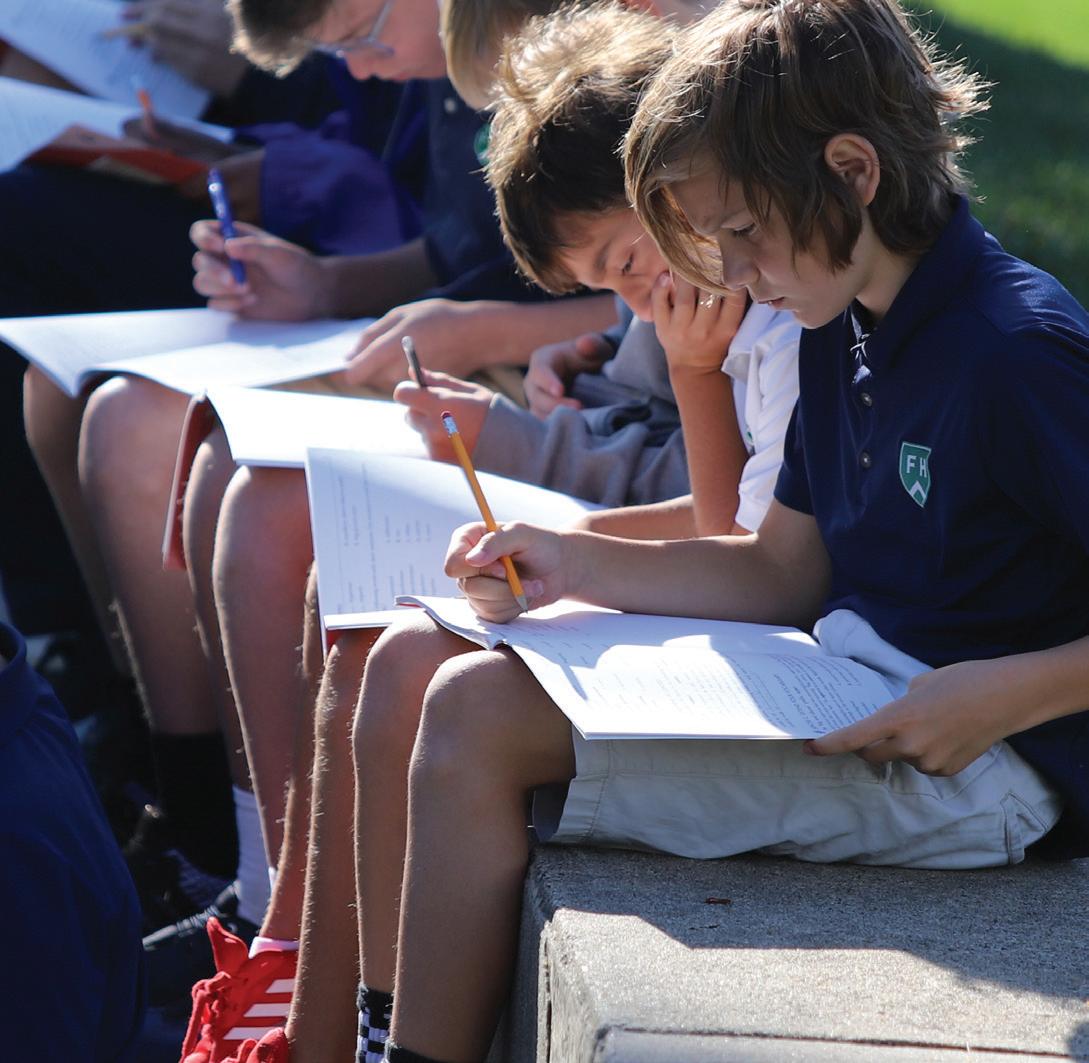
• students will provide evidence to support their arguments in writing; and
• understand the connections among the representational forms of fractions, decimals, and percents and use them to efficiently and accurately calculate percent of numbers.
Grade 7 English class introduces students to a wide range of fiction and non-fiction texts. The year begins with an intense study of classic short stories such as The Tell Tale Heart by Edgar Allan Poe and ends with a unit study on historical fiction. Students read Laurence Yep’s Dragonwings about the Chinese Immigration experience at the turn of the 20th century. In connection with their investigation of World War II, students read The Diary of a Young Girl by Anne Frank. These anchor texts launch writing projects, both analytical and creative. Students take ownership of the writing process at this level, engaging in peer editing and revising with each draft. Students study vocabulary from Greek and Latin roots. Building on the five-paragraph essay work done in Grade 6, Grade 7 students write more extended essays with a thesis statement supported by evidence from the text. Daily homework and independent classwork reinforce critical skills taught in whole group instruction and small group work.
Grade 7 History focuses on select themes and time periods in American History post-Civil War. By studying periods such
as Reconstruction, Westward Expansion, the Gilded Age, World War I, the Jazz Age, the Great Depression, World War II, and the Cold War, students develop a portrait of the nation in the 20th century. Grade 7 History includes writing a research paper on a student’s chosen topic. This project allows students to develop a thesis statement, utilize research skills to access primary and secondary sources, annotate, and properly cite information. Writing skills and organization of information are also a focus. Homework and classwork throughout the year help students prepare for this hallmark project.
Far Hills Country Day School Upper School students are placed on one of two math tracks after Grade 6:
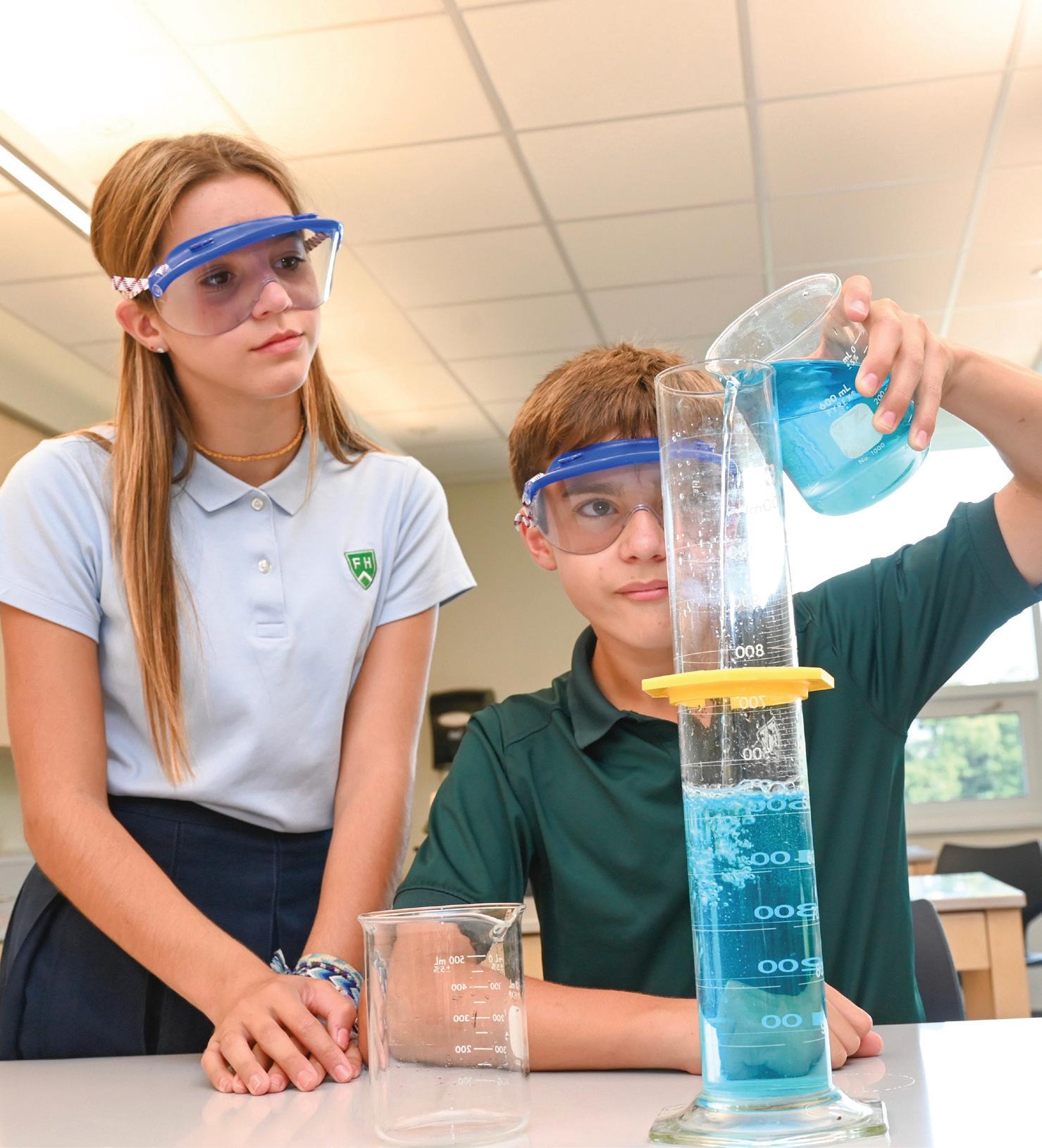
• PreAlgebra (Grade 7) to Algebra (Grade 8)
• Algebra (Grade 7) to Geometry (Grade 8)
Grade 7 PreAlgebra students learn to solve problems involving percent applications, such as those in commerce and banking, and calculate percent of change. Using their understanding of perimeter and area of two-dimensional shapes, students derive surface area and volume formulas. Students learn to navigate irrational numbers through their work with squares, cubes, and roots as the real number system
is introduced. The Pythagorean Theorem provides an avenue to apply this understanding. Students spend time analyzing data presented in various formats to calculate key measures depending on the context provided. They also extend their knowledge of probability to include independent and dependent events and compound probability. As students prepare for Algebra, they delve more deeply into algebraic expressions, equations, and inequalities.
Grade 7 Algebra students obtain the foundation for future coursework in mathematics. Students study equations in two variables after reviewing and extending their understanding of equations and
inequalities, including absolute value. Following a natural progression from linear equations through systems of equations and inequalities, students discern how to write and solve equations to model various real-life situations. The study of exponents and roots is extended as exponential functions are explored. After introducing polynomial operations and factoring, students dive into a study of quadratic functions. An understanding of how to simplify and operate with radical expressions is incorporated as students work with the quadratic formula.
Grade 7 students study the earth’s structure, forces that shape the
world, tectonic plate theory and the dynamics of the atmosphere and the oceans, geologic time, and the basic design of the solar system. Broad themes, such as heat distribution within the Earth’s atmosphere and interior asthenosphere, unity and diversity, scale and structure, systems and interactions, energy, and patterns of change, form the context within which specific content is addressed. Conceptual development is fostered by involving students directly in scientific inquiry. Laboratory activities emphasize skills to answer questions by collecting quantitative and qualitative data.
In Grade 7, students continue to build upon their knowledge base with more advanced grammatical constructions and richer vocabulary. Students study and employ irregular verbs, reflexive verbs, and pronouns with greater frequency and accuracy. The simple past tense is also introduced. Students explore themes such as school life across cultures, travel, health and wellbeing, and sports and games.
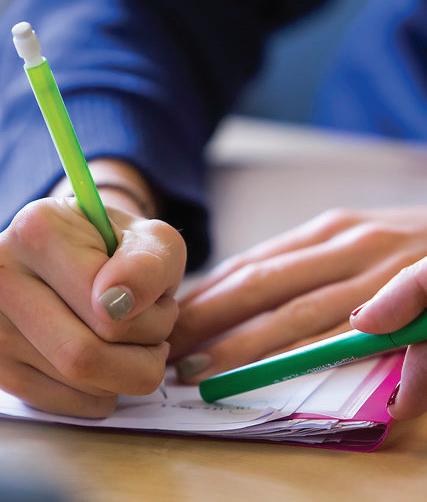

Signature Project: Students read two shorts novels in Spanish throughout the year and demonstrate their understanding of it through creative projects such as a graphic novel writing, illustration, and moviemaking.
Grade 7 students continue their Latin language study by entering the world of Salvius and his family, Roman ambassador of Great Britain, and political liaison to the emperor. Common themes of territorial expansion and the nature of an “empire” are explored in our stories. The differences between the various past tenses in both English and Latin are the linguistic focus of the course. Ancient Egypt and its cultural, religious, and geopolitical impact on the Roman Empire are explored. Linguistically, a significant amount of instructional time is dedicated to mastering noun declination. Every third-year Latin student can identify the case, number, and gender of any noun encountered during translation. This course encompasses all of Unit 2 of the Cambridge Latin Course.
In addition, Grade 7 Latin students complete the “Ancient Wonders of the World” project. They research and present a synopsis of one of the Seven Wonders of the Ancient World, all of which held cultural significance in classical times and are instrumental in understanding their values as a society.
Grade 7 musicians examine the origins, styles, artists, and instrumentation of Jazz, then they compose a Jazz musical piece using Soundtrap. Students also compose and perform music using
traditional classroom instruments, Chromebooks, and keyboards in the Keyboard Lab, demonstrate proficiency in music literacy skills, including reading and writing melodic notation in the Treble and Bass clefs and reading and writing rhythmic notation including quarter, half, dotted half, eighth, sixteenth notes and their corresponding rests, and sing on pitch with proper posture, demonstrate appropriate vocal production in both the upper and lower registers in the classroom and at our formal concerts.
Grade 7 artists explore self-portrait painting, connecting Math and Diversity, Equity, and Inclusion with Visual Art. Students create a photorealistic self-portrait painting using a grid transfer process and painting style made famous by famed artist Chuck Close who overcame multiple physical obstacles and limitations. Students learn about sculpture as an art form and how everyday objects and materials can create a freestanding sculpture. Students create Pop Art clay food sculptures from kiln-fired clay and glazes. Using research gathered in Science about a specific constellation, students visually express this understanding through the usage of watercolors, copper wiring, and an LED bulb and battery.
Grade 7 students exhibit independence as they take more ownership in selecting what helps their organization and learning. Digital Citizenship topics go more in-depth about digital footprints and thinking before posting. Coding skills move to an intermediate level as students rely on previous knowledge to work with timers and interactions between objects. Programming
in JavaScript is introduced to all students, and students can choose to increase their skills in JavaScript or Python if interested.
Grade 7 students explore leadership roles in the Upper School, the mission skills curriculum shifts to focus on developing creativity, resilience, and ethics. Through our advising program, students explore how navigating middle school requires creativity and resilience. Identifying areas for growth with their advisor helps students set goals for each trimester. An introduction to ethics and the development of leadership skills takes place during weekly Wellness classes. These lessons and reflections allow students to assume leadership roles the following year in Grade 8.
The guiding principles of the Upper School Athletic programs are: best effort, best attitude, best teammate. Through participation in sports and non-competitive activities students demonstrate the skills necessary to be successful in both team and individual sports. Students also have the opportunity to participate in challenge-by-choice programs, including our Ropes Course and Mountain Bike Trail.
By the end of Grade 7, Far Hills Country Day School students will be able to:
• simplify algebraic expressions using the principles of the Distributive Property and combining like terms and extend to solving equations and inequalities;
• create a thesis statement and support it with evidence from the text;
• write a multi-paragraph essay with transition sentences;
• demonstrate their understanding in a variety of ways including traditional formative and summative assessments, oral presentations, and writing assignments; and

• analyze data and calculate the probability of singular and compound events.




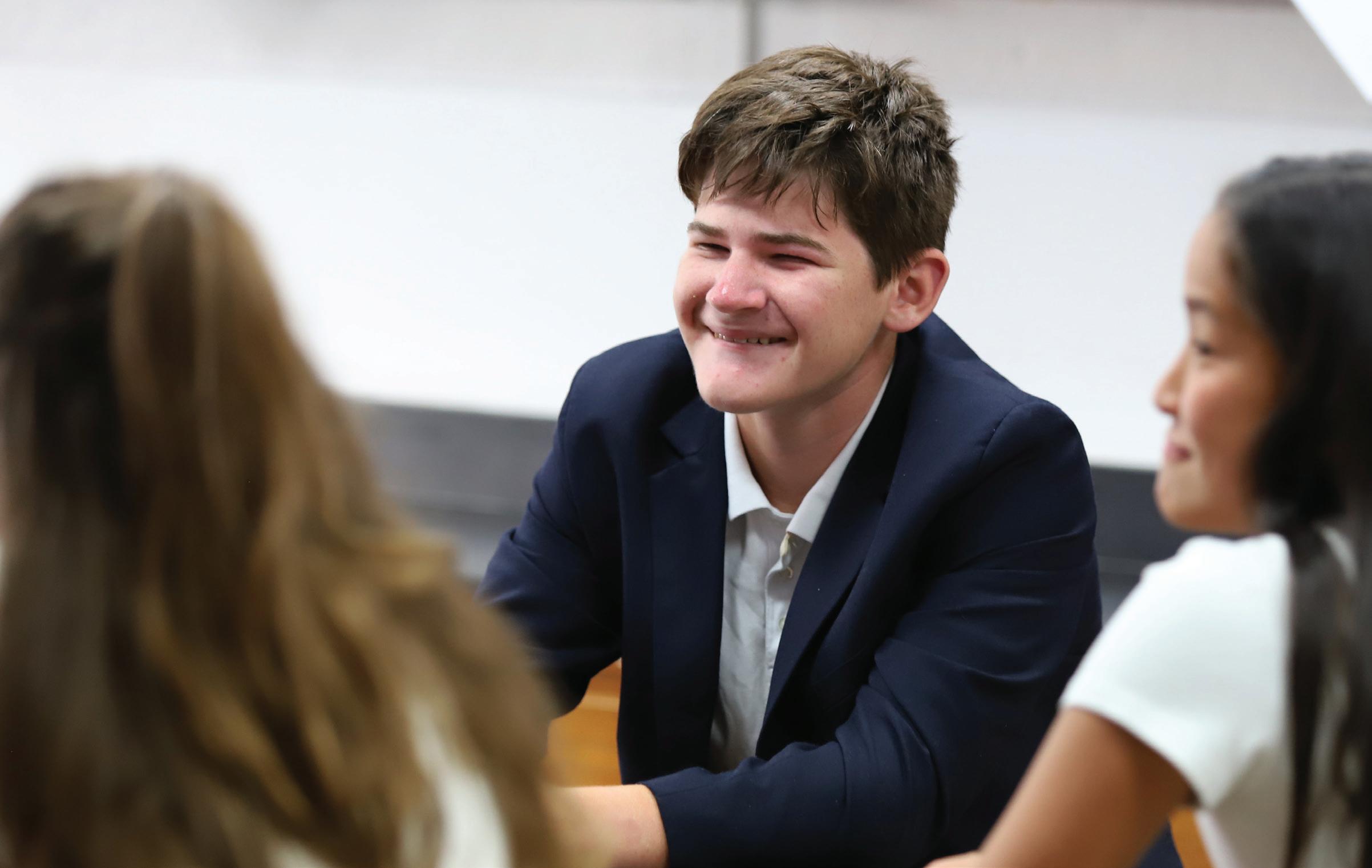
English
Grade 8 English introduces students to the challenging texts of high school literature classes. In connection with history, students use the lens of leadership to study various characters and plots in literature. Beginning with a study of Malala’s memoir, I am Malala, students study the genre and write a memoir of their own. Connecting this process to their secondary school applications allows the students to see the real-world application of solid writing skills. Through the study of complex works such as Macbeth, Lord of the Flies, and Fahrenheit 451, students are challenged to read, write, and discuss how leadership is explored in literature. Students continue their study of Greek and Latin roots, which began in Grade 5. Students are expected to be confident readers and writers and engage in these activities daily.
The Grade 8 History course focuses on modern world history. Studies focus on the continents of Asia and Africa, the interconnectedness of world cultures, societies, and governments, characteristics and forms of leadership, the impact of colonialism in many countries, and the influence that much of this history has on today’s world events. History comes alive for students when we connect history with current events and trends.
The Grade 8 Learning Exposition,
a capstone project, takes place during the third trimester. Students develop an independent research study on a self-selected topic. In connection with English, students interview an expert in their field of study. Independent learning skills are emphasized through various activities and assessments, culminating with the final exposition.
Far Hills Country Day School Upper School students are placed on one of two math tracks after Grade 6:
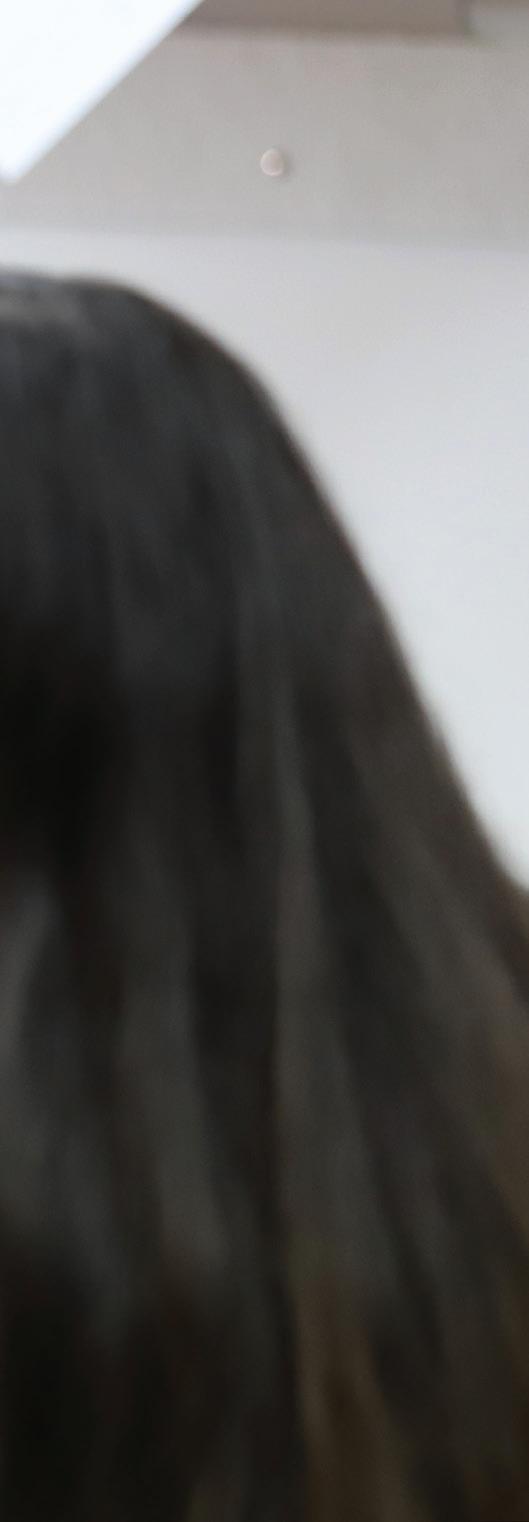
• PreAlgebra (Grade 7) to Algebra (Grade 8)
• Algebra (Grade 7) to Geometry (Grade 8)
Grade 8 Algebra students obtain the foundation for future coursework in high school mathematics. After reviewing and extending their understanding of equations and inequalities, including absolute value, students study equations in two variables. Following a natural progression from linear equations through systems of equations and inequalities, students discern how to write and solve equations to model various real-life situations. The study of exponents and roots is extended as exponential functions are explored. After an introduction to polynomial operations and factoring, students dive into a study of quadratic functions. Understanding how to simplify and operate with radical expressions is incorporated as students work with the quadratic formula.
The Grade 8 Geometry course establishes key vocabulary and terminology central to the study. Students work with the midpoint and distance formulas and explore angle relationships with parallel and perpendicular lines. They prove triangles congruent or similar, investigate proportionality in similar triangles, analyze relationships in right triangles, and study the properties of circles while being introduced to trigonometry. An emphasis is placed on algebraic topics within each geometry course of study. Students also learn to reason and provide justifications for their process by writing proofs.
Grade 8 students investigate physical science by studying chemical matter and its interactions and force motion. Models are used to help students to build upon previous concepts to deepen their understanding of chemistry.


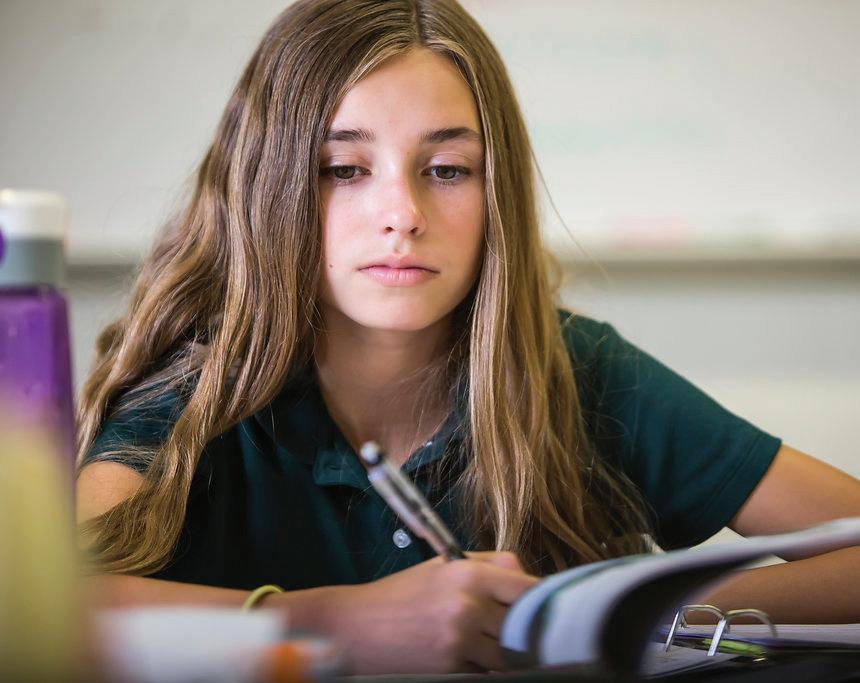
Students use the kinetic molecular theory to help them explain the states of matter and how chemicals react. In addition, they learn about trends and use the periodic table. Students collect and analyze data from a vehicle that they build as a culminating project in our physics unit.
In Grade 8, students reach the Novice High proficiency level of language learning, having mastered the elementary skill sets of listening, speaking, reading, and writing in Spanish. Students develop and give several presentations in the target language and learn how to communicate appropriately at length in email/letter format. Students showcase their creativity in the language by creating menus, building websites, and designing 3D-model homes all in the target language.
Signature project: “El escape cubano”: Students research the history, geography, and culture of Cuba, read the novel “El escape cubano” and write, record, and edit a telenovela-style adaptation of the novel.
Having completed Units 1 and 2 of the Cambridge Latin Course, Grade 8 students begin a new textbook titled Suburani (City-dwellers), bringing our curriculum to the intermediate level of language proficiency. This new course encapsulates and reviews elementary Latin while introducing new concepts and vocabulary from a different historical perspective. The Latin language program at Far Hills Country Day School concludes with the administration of the National Latin Exam, a standardized metric that gauges student proficiency across the country and offers our students a recommended language placement for secondary school.
In addition, Grade 8 Latin students complete the “Ancient History News Report” project. Students conduct research into a current event in the world of classical civilization,
as discoveries are still being made daily. They share their findings in a presentation, highlighting the relevance to the curriculum and the repercussions of the discovery on the modern world.
Grade 8 students collaborate and create musical circuits using conductive materials and a Makey Makey device in Music class. Past projects include a human synthesizer, a banana piano, and a staircase keyboard. Grade 8 musicians also continue to compose and perform music using traditional classroom instruments, Chromebooks, and keyboards in the Keyboard Lab, demonstrate proficiency in music literacy skills including reading and writing melodic notation in the Treble and Bass clefs and reading and writing rhythmic notation including quarter, half, dotted half, eighth, sixteenth notes and their corresponding rests, and sing on pitch with proper posture, demonstrate appropriate vocal production in both the upper and lower registers in the classroom and at our formal concerts. Grade 8 students learn about the history of Rock music, taking a close look at the artists, the music, the instrumentation, evolving technology, and how national events influenced the music and culture of the times.
Grade 8 artists explore the world of stop motion animation during Visual Art class. They develop a simple storyline that is animated using handmade characters and props (i.e., clay or paper) and found objects. Movies are filmed using stop motion animation software and are narrated or set to music. When Grade 8 artists create Japanese Manga, it is connected to history and the English curriculum. Students develop a character rooted in traditional manga techniques but altered and reflective of their physical attributes. A blackout poetry piece (designed using music lyrics from their favorite song) accompanies the portrait to make
this a complete visual experience.
As Grade 8 students assume the student leadership roles of our community, they are given realworld opportunities to apply both the mission skills and Far Hills pillars. The student government officers exercise their leadership and time management skills as they plan school-wide activities during the school year. Editors of the yearbook tap into their creativity and responsibility to create a keepsake for the community. Team captains, service learning coordinators, and leads in the school play are just some of the many ways Grade 8 students practice the skills they have developed at Far Hills.
The guiding principles of the Upper School Athletic programs are: best effort, best attitude, best teammate. Through participation in sports and non-competitive activities students demonstrate the skills necessary to be successful in both team and individual sports. Students also have the opportunity to participate in challenge-by-choice programs, including our Ropes Course and Mountain Bike Trail.
By the end of Grade 8, Far Hills Country Day School students will be able to:
• understand linear and quadratic functions and their application to real-life situations;
• understand and practice the real-world applications of strong writing skills;
• write a multi-paragraph essay with strong arguments in support of a well-crafted thesis; and
• evaluate contemporary issues, figures, groups, or events and how they influence a community, nations, society, or the world.
